
- Introduction: A Winter Trip To Tokyo & Niseko
- Review: British Airways Lounge San Francisco Airport (SFO)
- Review: Japan Airlines First Class Boeing 777 (SFO-HND)
- Review: The Tokyo EDITION Toranomon, Japan (Great Views, But…)
- Review: The Tokyo EDITION Ginza, Japan (Exceptional Service)
- Review: Japan Airlines Domestic Class J Airbus A350 (HND-CTS)
- Review: Park Hyatt Niseko Hanazono, Japan (Stellar Ski Resort!)
- Review: Ritz-Carlton Reserve Niseko Higashiyama, Japan (Underwhelming)
- Review: ANA Lounge Sapporo Airport (CTS)
- Review: ANA Premium Class Boeing 737 (CTS-NRT)
- Review: ANA First Class Suite Lounge Tokyo Narita Airport (NRT)
- Review: ANA First Class Airbus A380 (NRT-HNL)
- Review: Hawaiian Airlines Business Class Boeing 787 (HNL-LAX)
- Review: Delta First Class Airbus A321neo (LAX-FLL)
For the next portion of our winter ski trip to Niseko, we flew Japan Airlines’ Airbus A350-900 Class J on the 1hr10min flight from Tokyo Haneda (HND) to Sapporo (CTS). Domestic aviation in Japan is absolutely fascinating, since both All Nippon Airways and Japan Airlines have dedicated domestic fleets, with high density layouts and different onboard products.
A while back, I reviewed Japan Airlines’ A350-900 first class on a domestic flight, and this time around, I got the chance to fly the carrier’s Class J. Note that while “J” often refers to business class, Class J is not business class. Instead, it offers the same service as economy, but with much more spacious seats, somewhat comparable to what you’d find in long haul premium economy.
Flying Japan Airlines’ A350-900s domestically is such a treat, given the general attributes of the A350, plus the seat back entertainment (including tail camera), free Wi-Fi, and friendly service. While I very much enjoyed the Class J experience, I do think first class is worth the premium, especially if you can score an upgrade for cash on the day of departure.
In this post:
How I booked my Japan Airlines Class J ticket
We booked our flights from Tokyo Sapporo with cash. Specifically, we booked the following for the per person cost of $168.14, directly in Class J:
3/04 JL513 Tokyo to Sapporo departing 11:30AM arriving 1:10PM
I should mention that we ended up booking this pretty last minute, so the fare was a bit higher than usual. Class J is such a good value compared to economy, as it only cost an extra $20 for our itinerary. For what it’s worth, often pricing in this market is even cheaper. It’s not unusual to see economy for under $80, and Class J for under $100.
Japan Airlines Class J lounge & boarding
Japan Airlines Class J tickets don’t include any sort of premium ground services, so you don’t get premium check-in or lounge access. However, this is where elite status really comes in handy. Thanks to my oneworld Emerald status, we got the same ground experience that you’d get if flying domestic first class.
Japan Airlines has a dedicated domestic first class check-in area, separate from the rest of the terminal. You can get your boarding passes and check your bags there. Then there’s a private security channel you can go through.
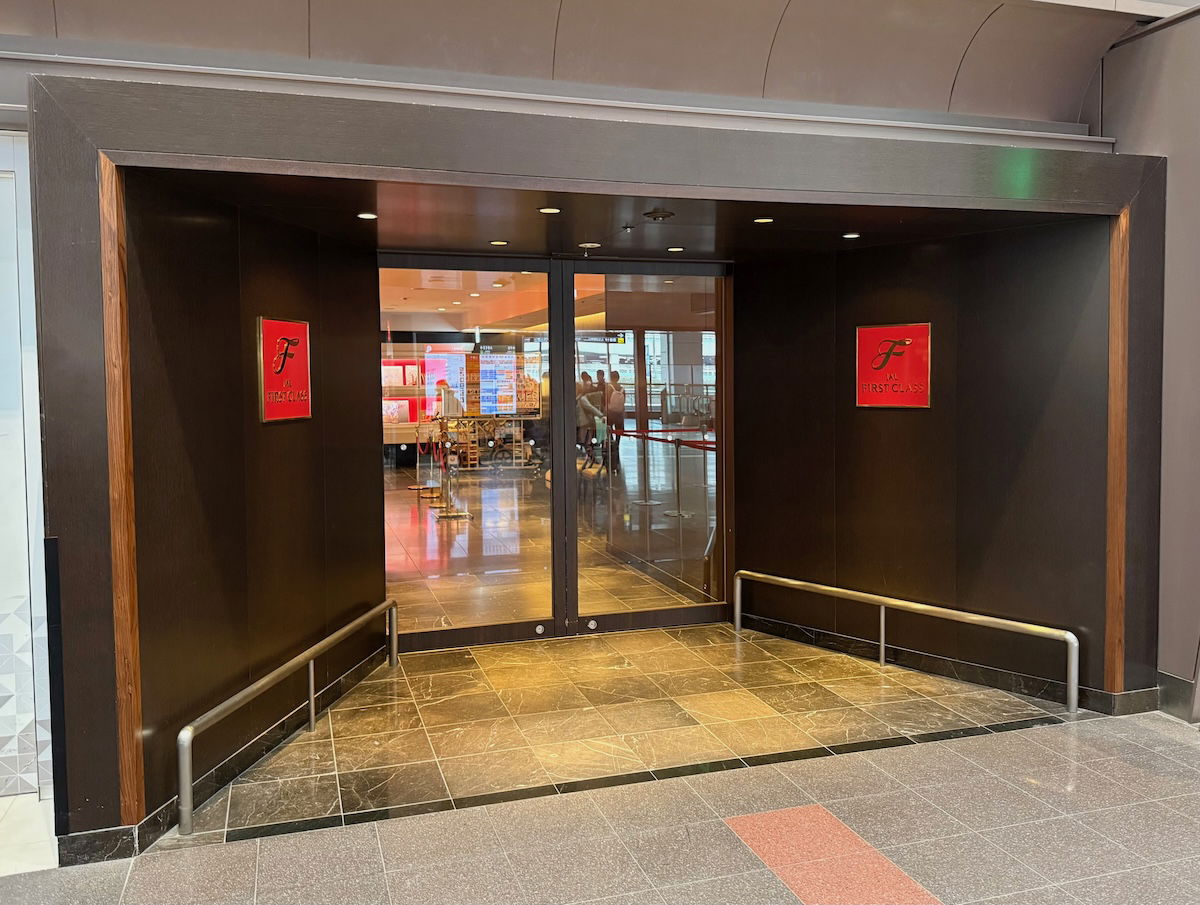
We then took the escalator up to the lounge.
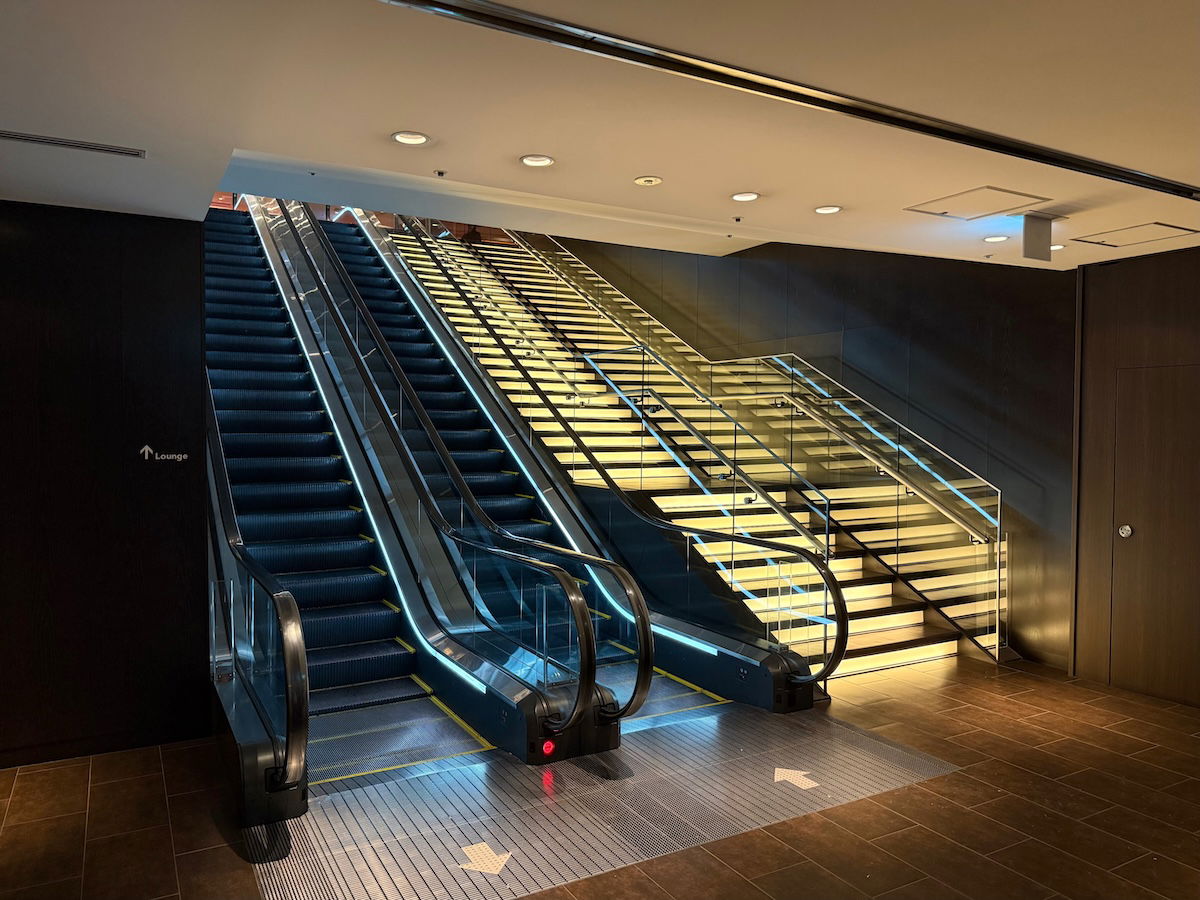
First class passengers and oneworld Emerald members get access to the Japan Airlines Diamond Premier Lounge. This is nothing like Japan Airlines’ international first class lounges, but it’s still a comfortable, quiet place to hang out, with great airport views.
As someone who lives in Miami, I just adore the culture of complete silence in lounges, where there are private rooms specifically for those who need to take phone calls. It’s quite a contrast to the speakerphone conversations we see in lounges in Miami.

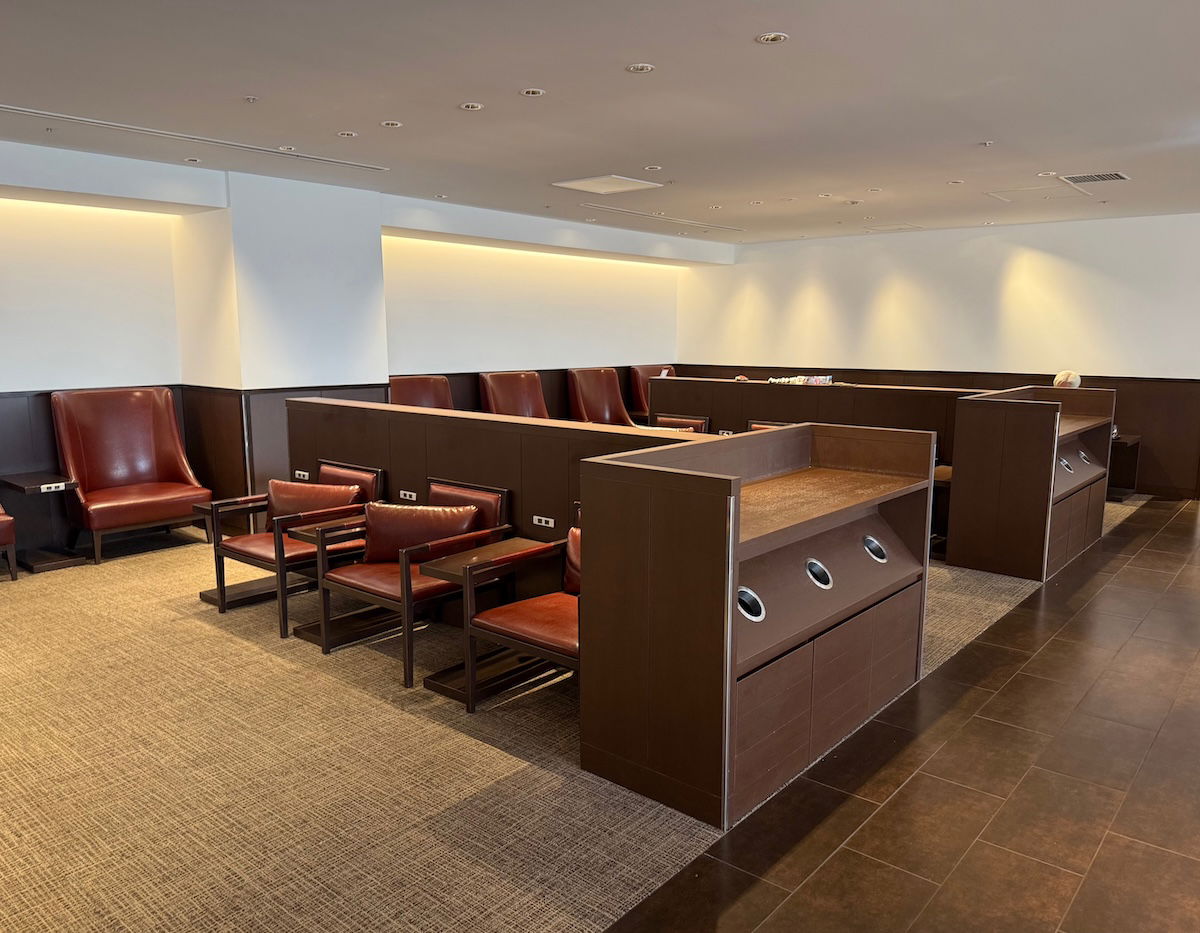
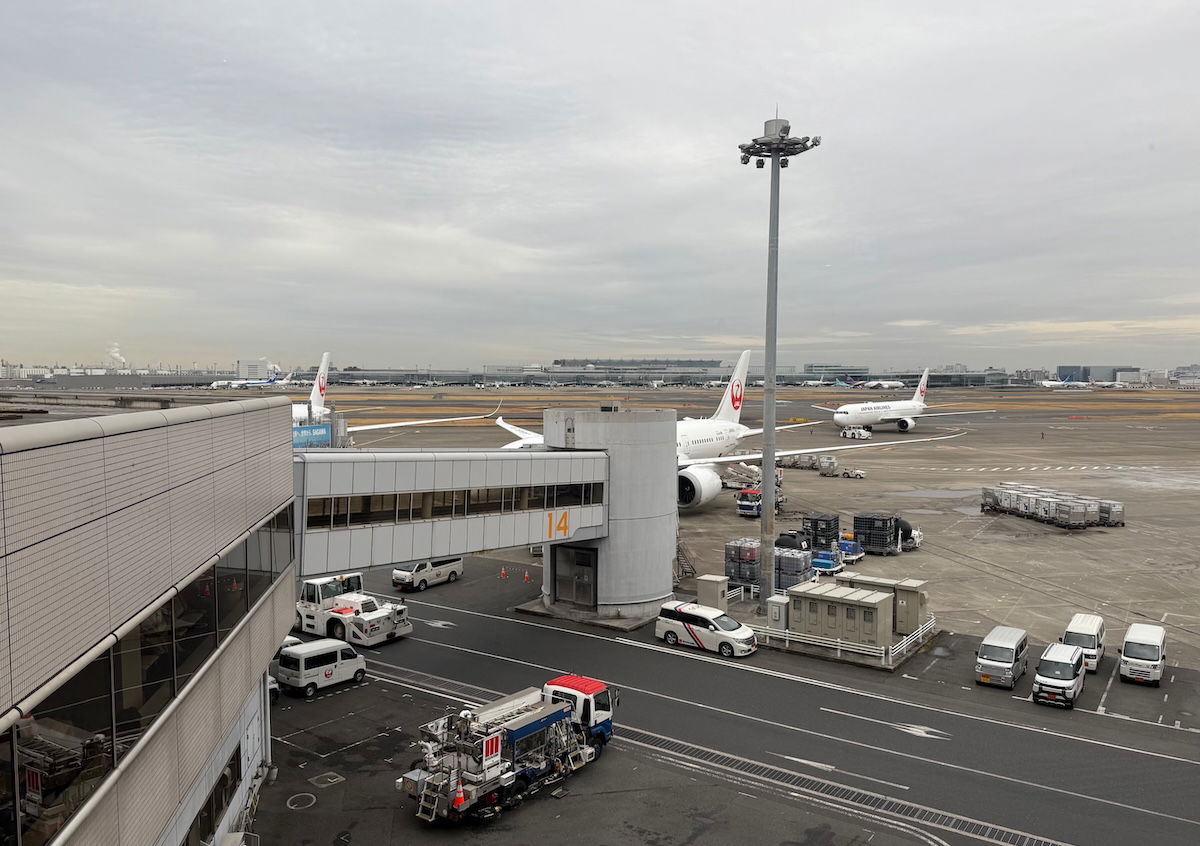
Our flight was scheduled to depart from gate 17, roughly a five minute walk from the lounge. Upon walking to the gate, we had a great view of JA14XJ, the three-year-old stunner that would be flying us.
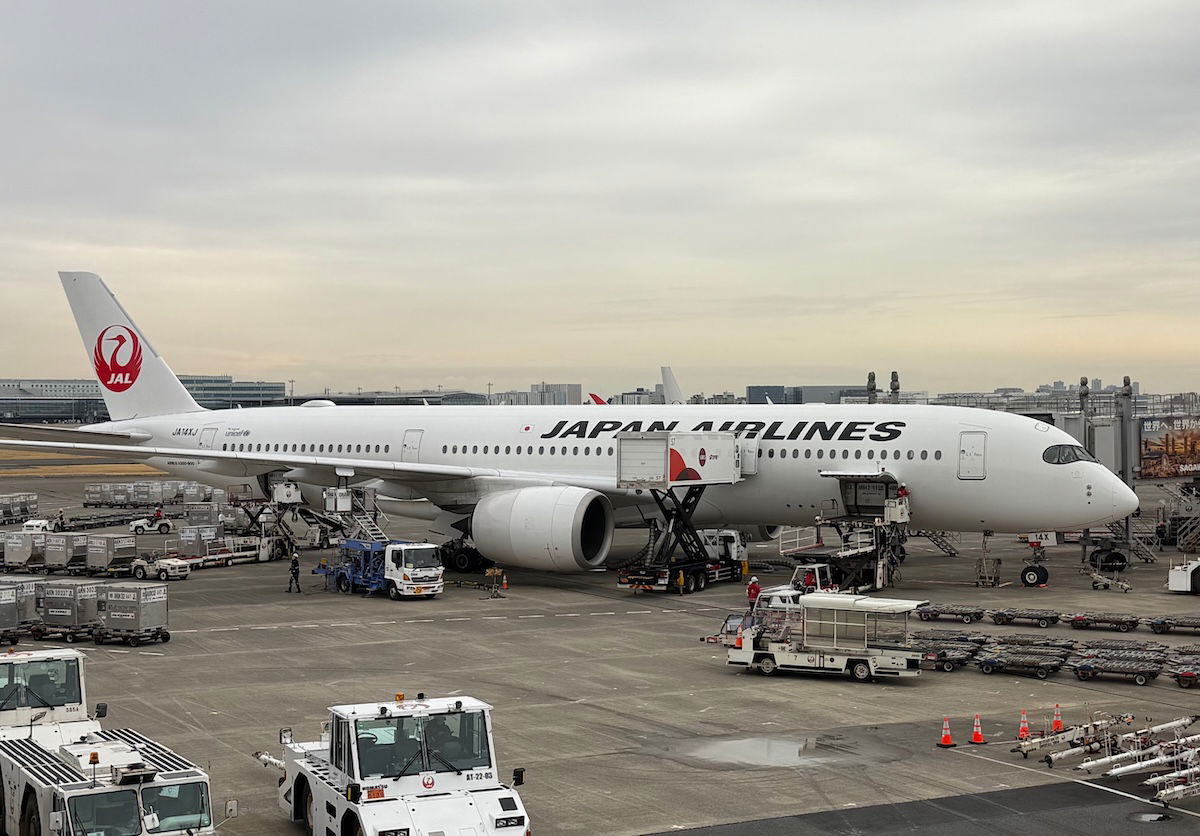
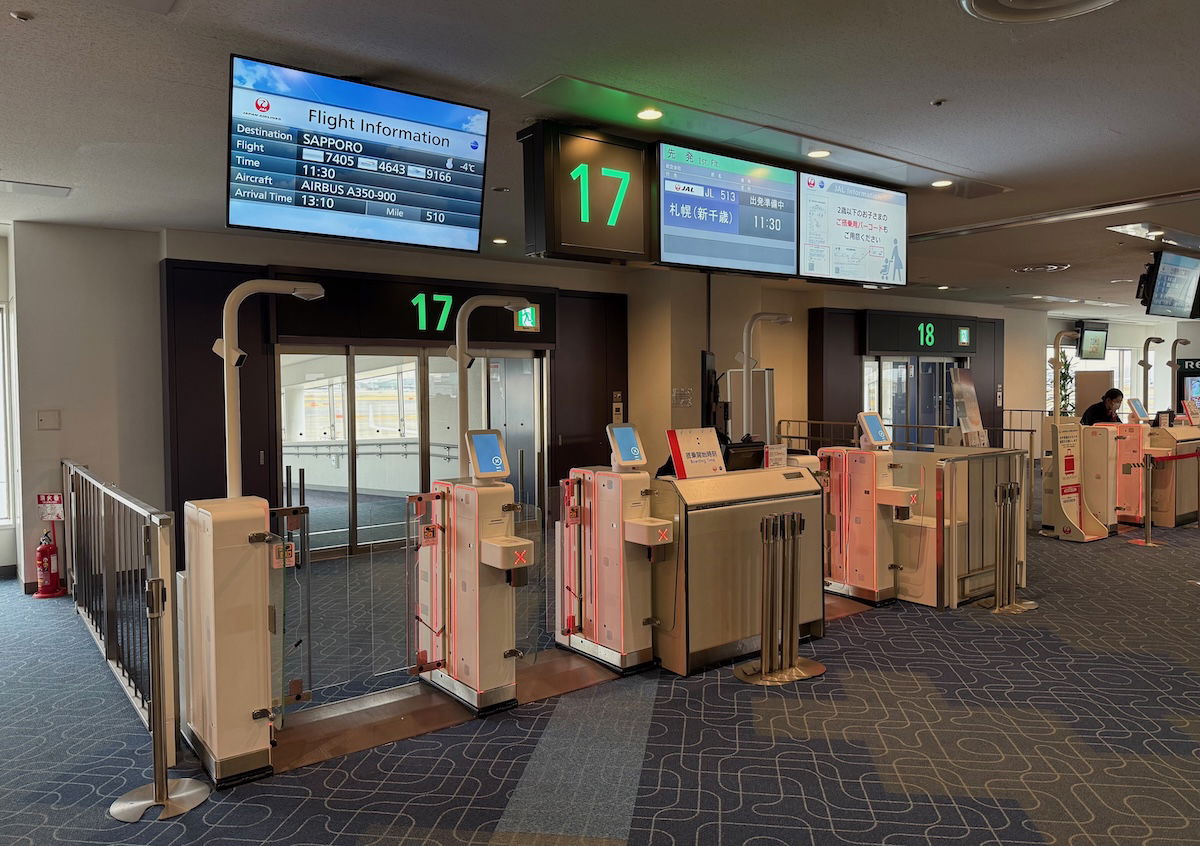
Boarding was scheduled to start 20 minutes before departure (you’ve gotta love Japan!), at 11:10AM. First class passengers and elite members are invited to board first. Ordinarily, Class J passengers board last, since Class J doesn’t come with priority boarding, and general boarding happens back to front. Still, on account of elite status, we could board at the start of the process.

Boarding started right on schedule, and was done via automated gates, so there was no human interaction. Despite that, the gate was ridiculously well staffed.
Japan Airlines A350-900 Class J cabin & seats
We boarded through the forward left door, where were greeted by the friendly crew, and first walked through the 12-seat first class cabin. We then found ourselves in the 56-seat Class J cabin (there’s also a version of the plane with a 94-seat Class J cabin).
Japan Airlines’ Class J seats are based on the Recaro PL3530 platform, with seats arranged in a 2-4-2 configuration. The first class and Class J cabin take up the entire space between doors one and two.
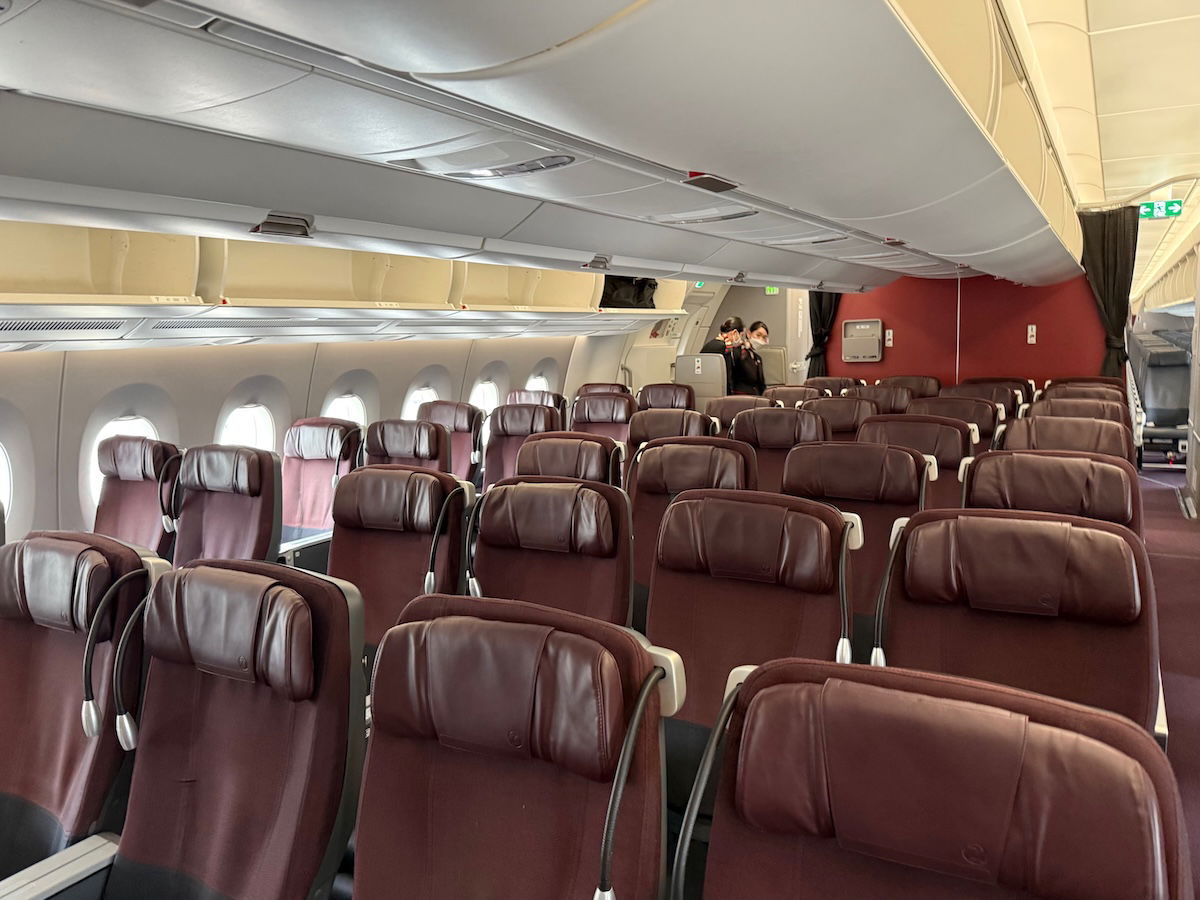
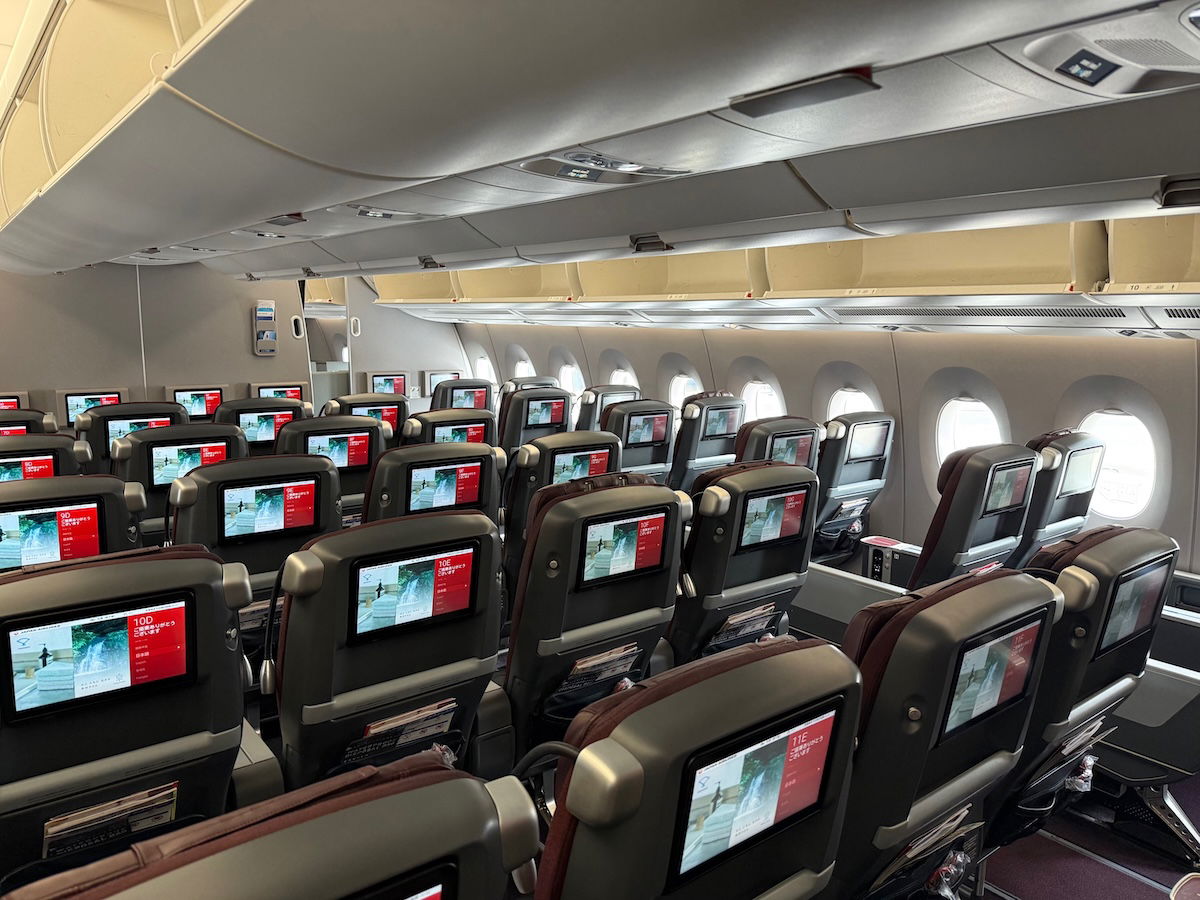
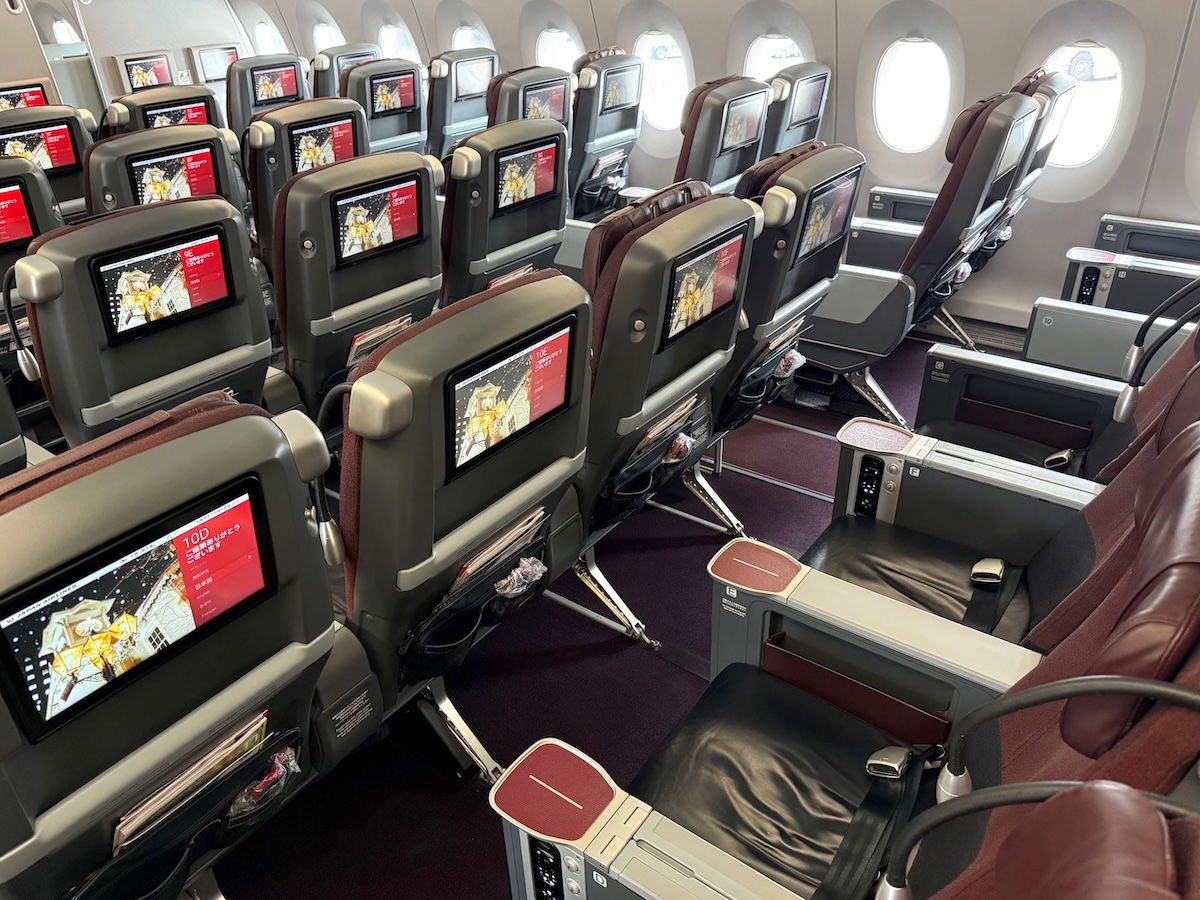
We assigned ourselves seats 11A and 11C, the window and aisle seat on the left side in the last row of Class J. Class J seats have 38″ of pitch, 19″ of width, and 8″ of recline, with a four-way adjustable head rest. So the seats are comparable to what you’d find in premium economy on long haul flights on many airlines, and are more than sufficient for the short missions this aircraft operates.
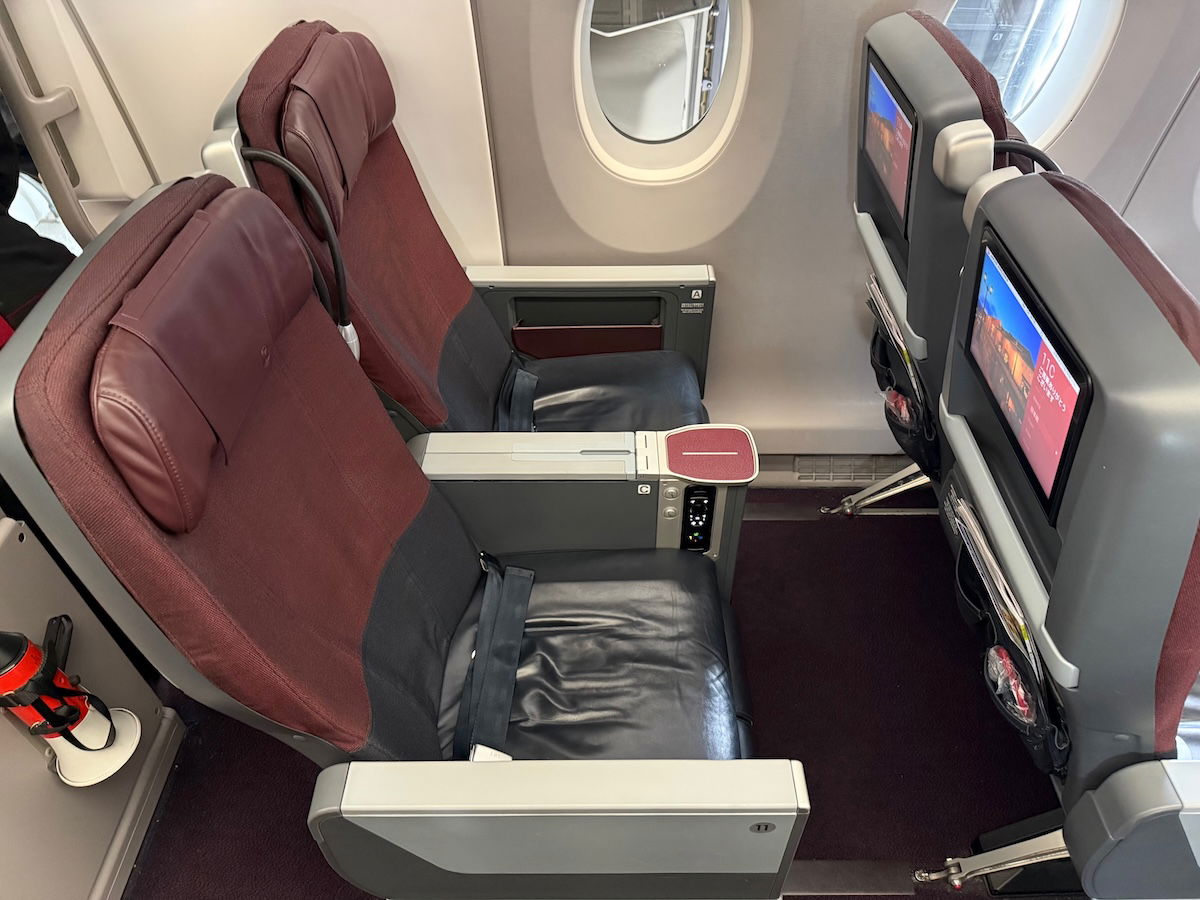
Each seat features an 11.6″ high definition touchscreen seat back monitor. There’s also a seat back pocket, with a couple of different compartments.

The armrest between seats has a space for drinks, and also has buttons for reclining the seat and raising the leg rest. There’s also an entertainment controller, though that seems largely unnecessary, given that the monitor is touchscreen.

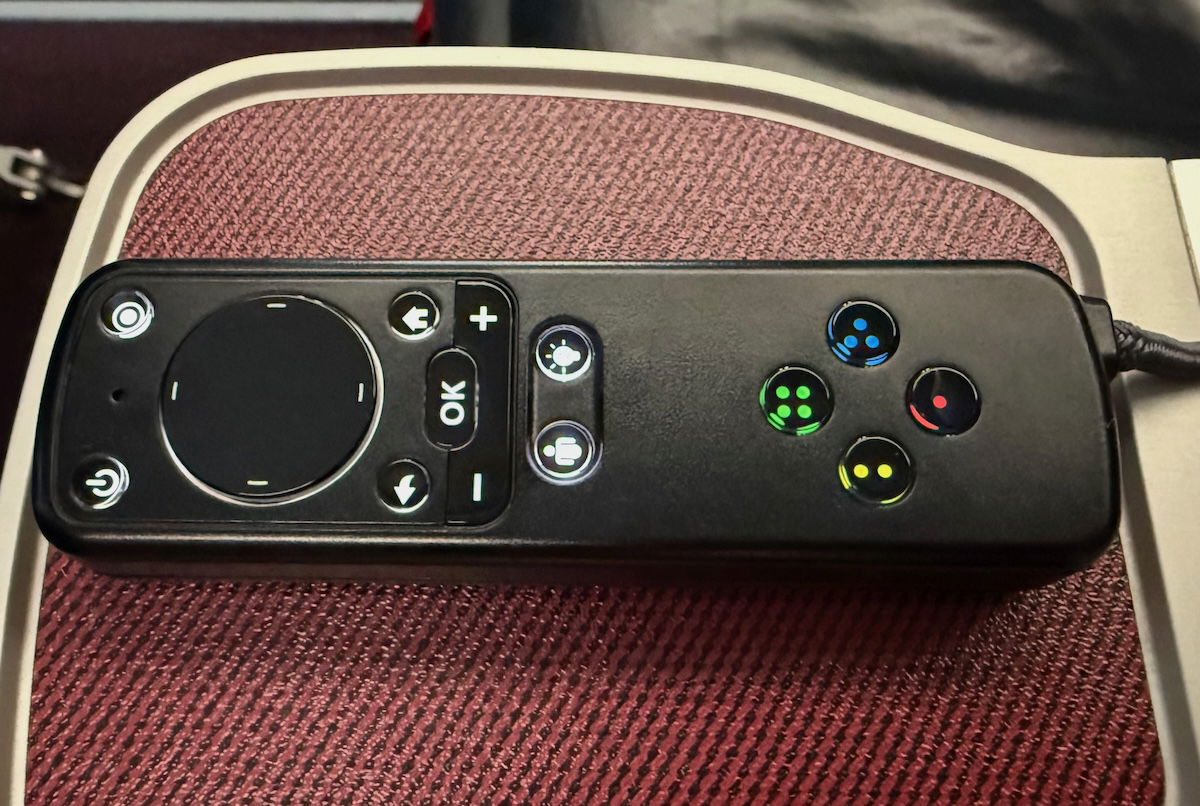
You’ll also find a couple of universal AC power outlets underneath the center console, for keeping electronics charged.
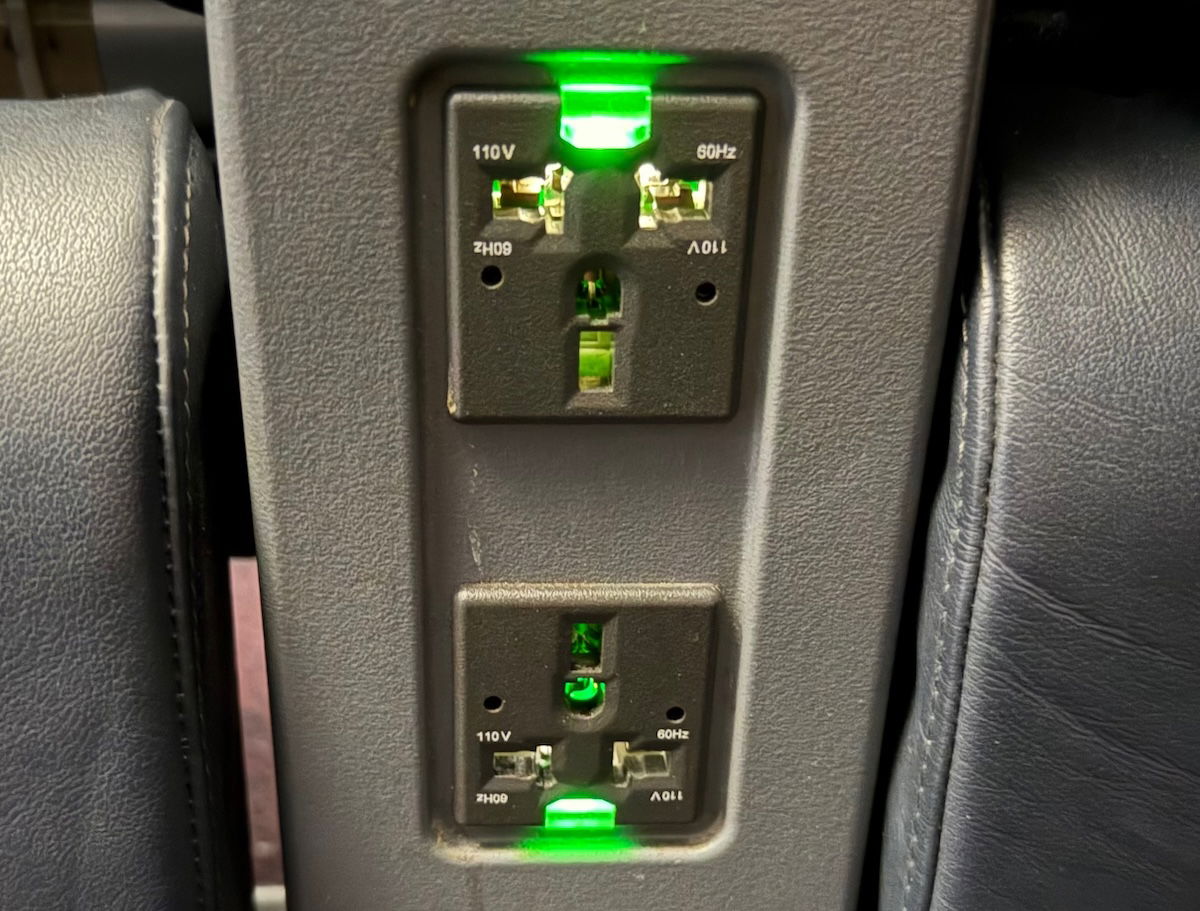
The tray table also folds out from the center armrest. When stored, it’s folded in half, so you just have to flip it over to make it the full size.
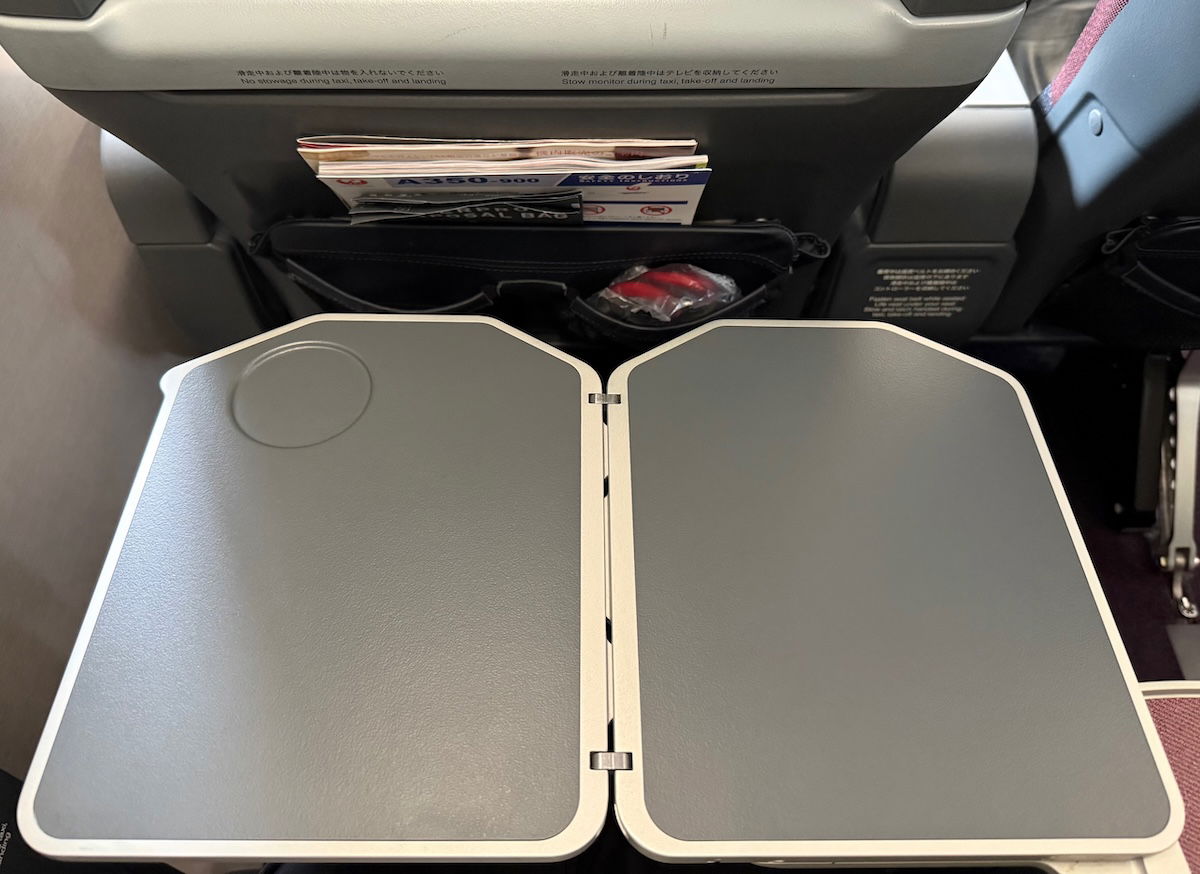
The far armrest has an additional storage pocket, though it’s not very deep.
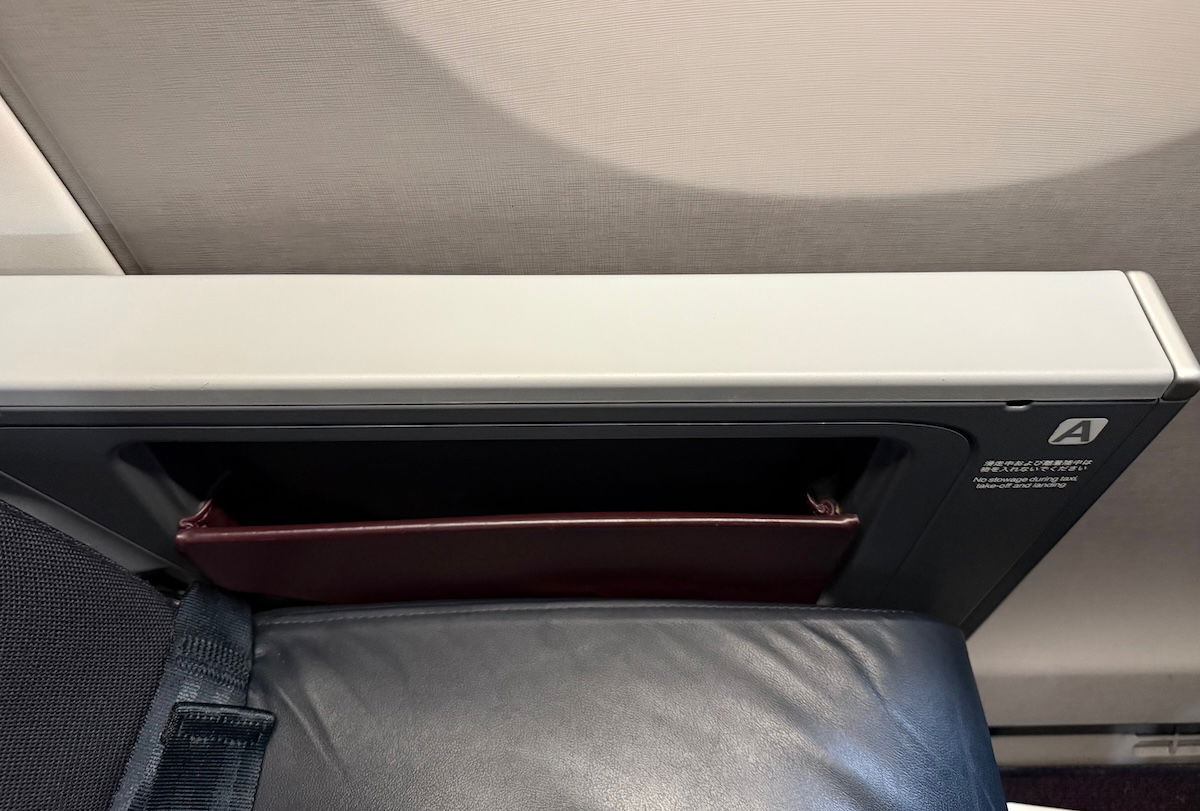
The overhead consoles were modern, as you’d expect on an A350, though they didn’t have any individual air nozzles.
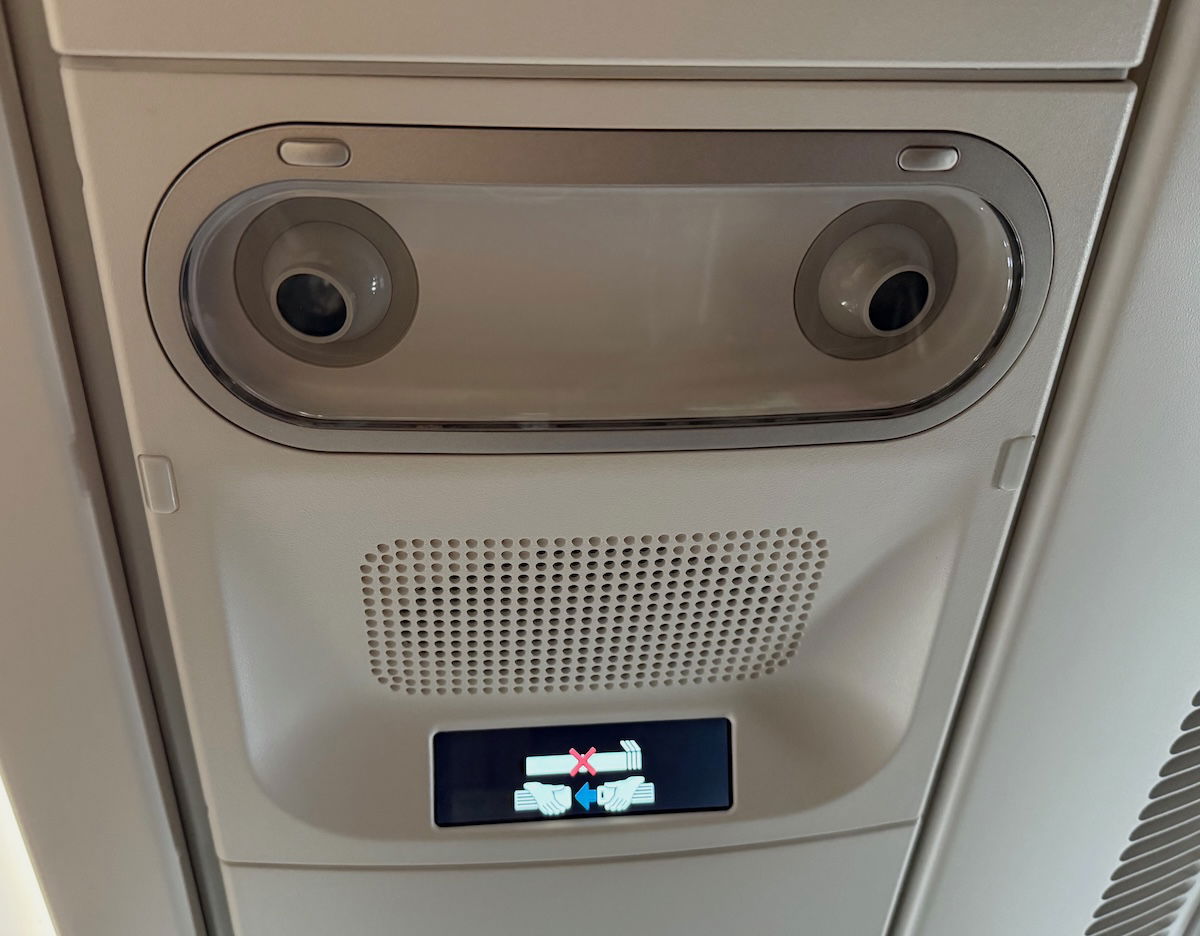
As far as amenities go, the only thing worth mentioning is that there were a pair of basic headphones that could be used during the flight.
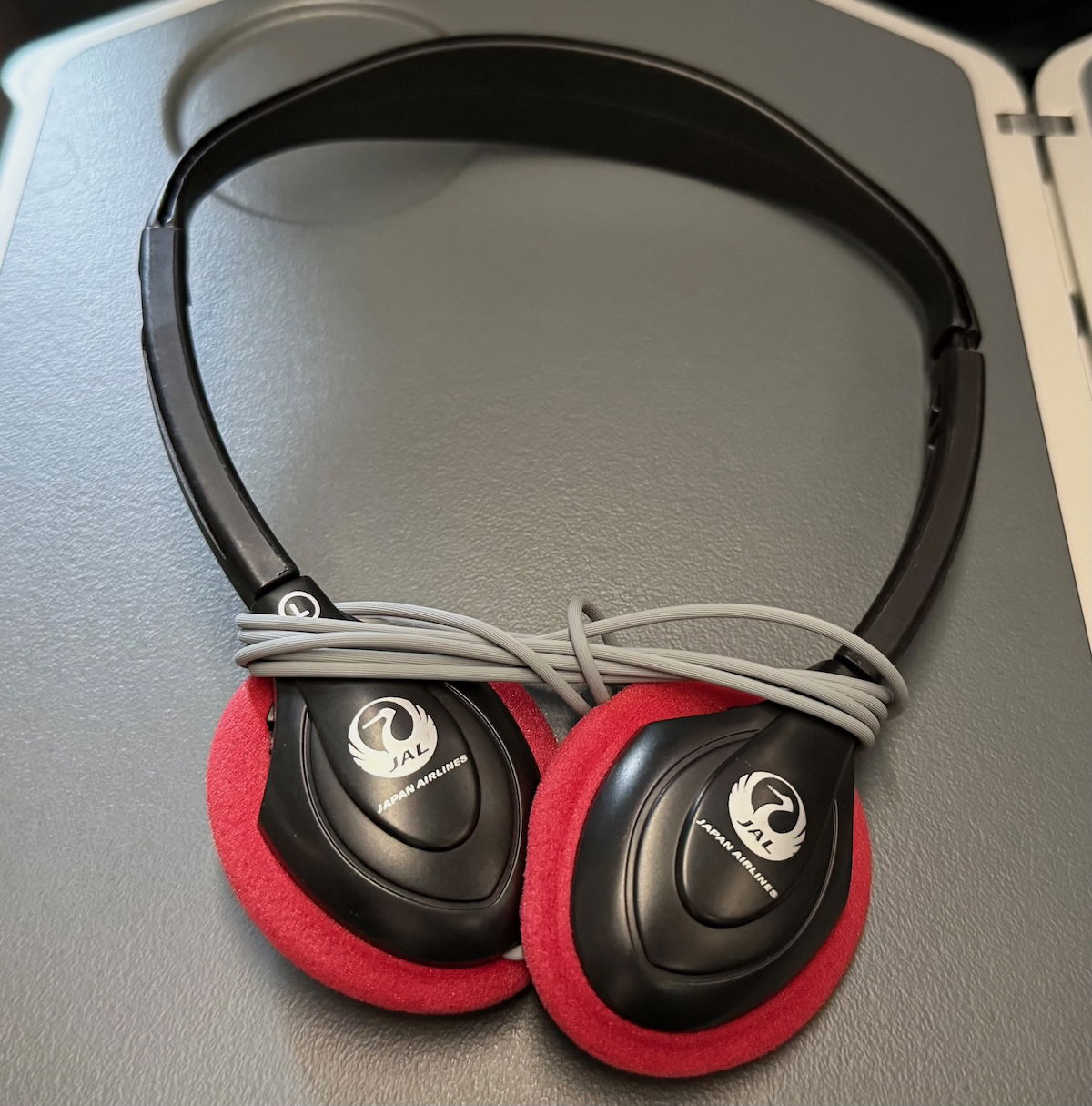
Japan Airlines A350-900 Class J entertainment & Wi-Fi
Japan Airlines’ domestic A350s have a different entertainment system than you’ll find on many long haul jets, but it’s still quite good. There are a variety of movies, TV shows, audio, and of course the map feature. There were around 25 movies and around 100 TV shows in the library, so it’s not a huge selection, but it should be easy enough to stay entertained for a short flight.
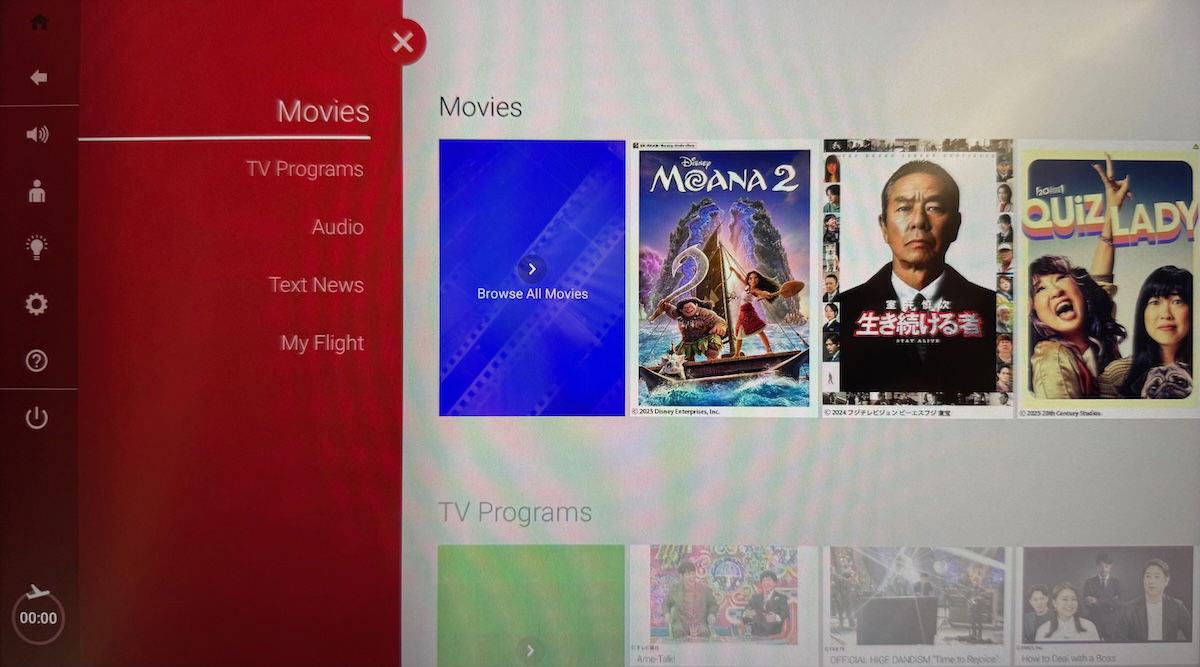
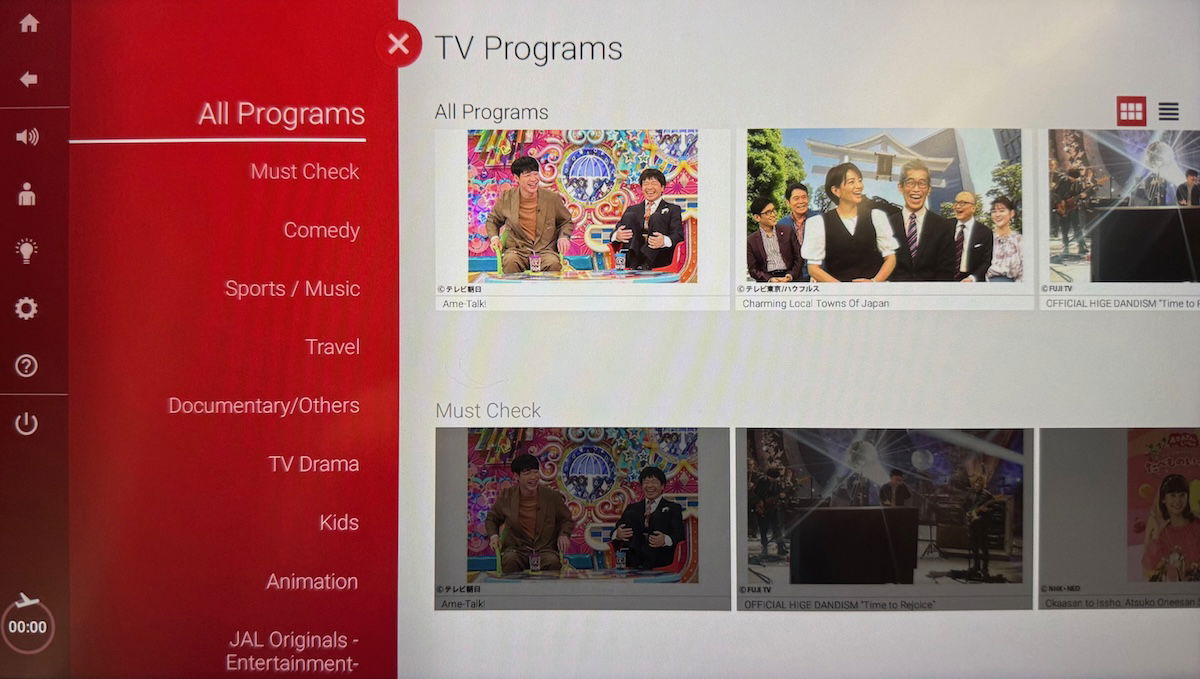


My favorite part of the entertainment system was the tail camera, which is something that I love about the A350 (for the airlines that choose to offer it).
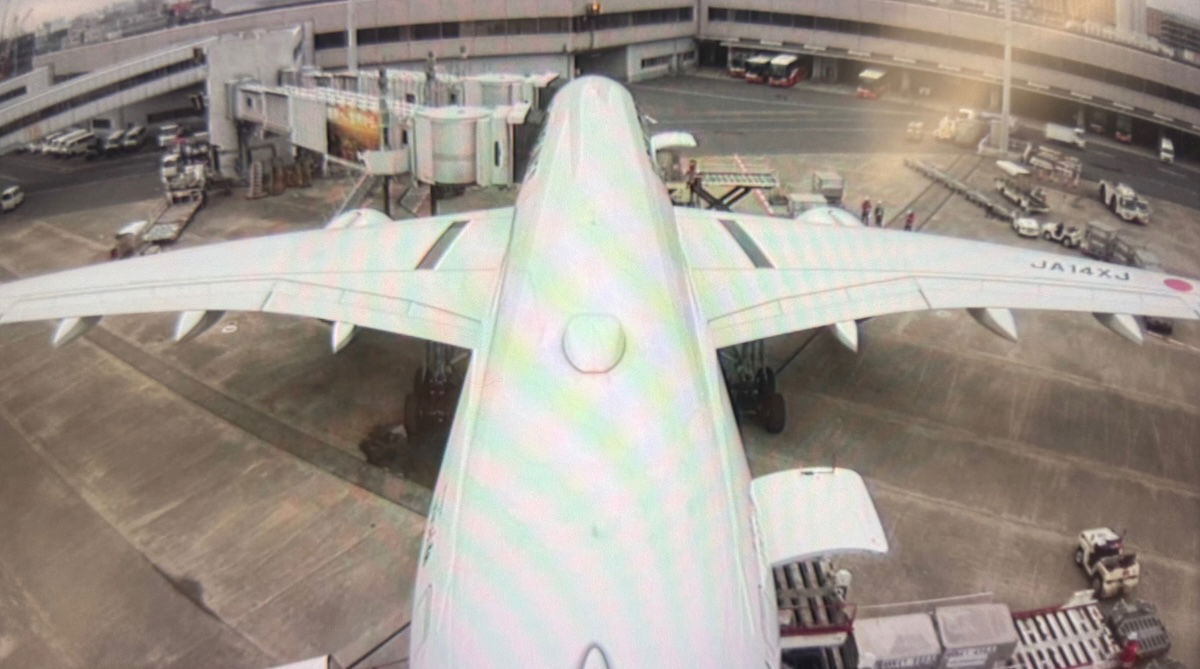
Japan Airlines even offers free Panasonic Wi-Fi on its domestic A350s, so all passengers can connect with just one click. I found the Wi-Fi speeds to be excellent, and it’s nice to be able to connect all your devices so easily, with no data caps.
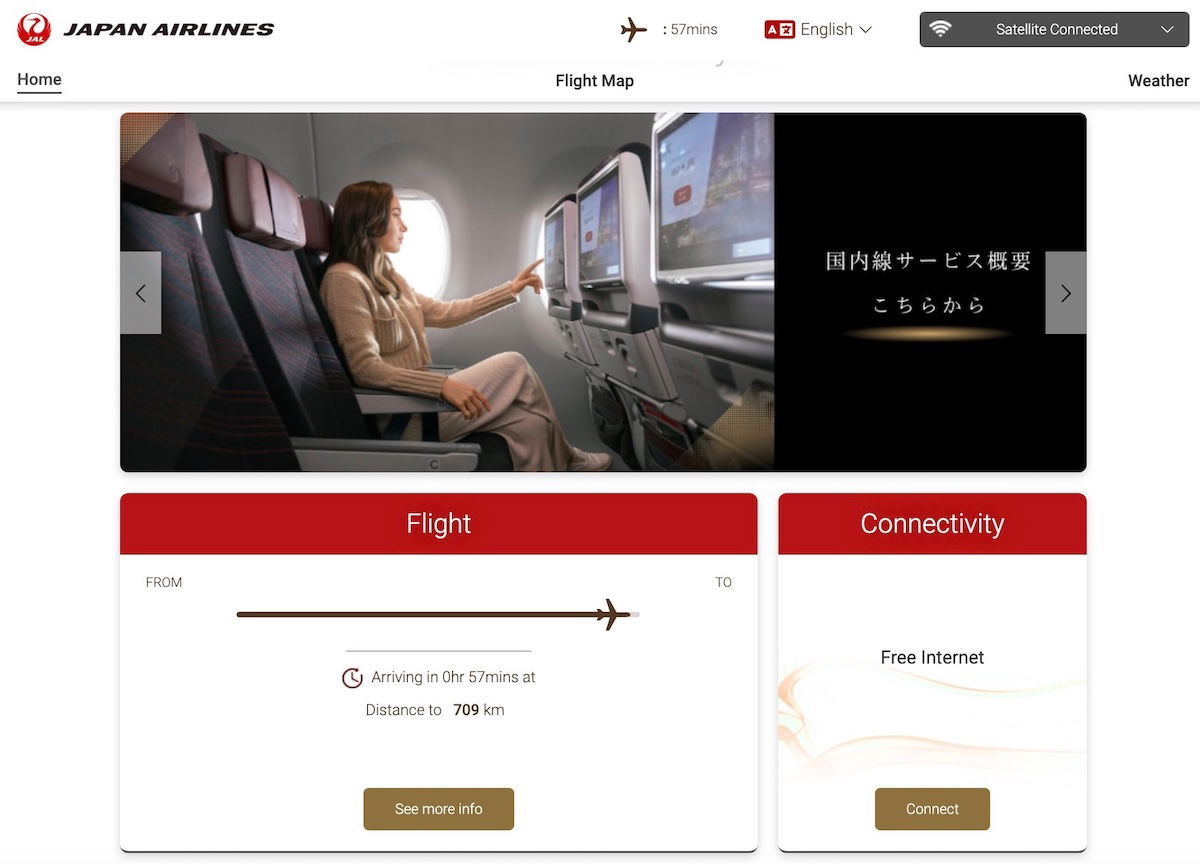

Between a modest movie and TV selection, the map, the tail camera, and free Wi-Fi, you shouldn’t be bored on Japan Airlines’ A350.
Japan Airlines A350-900 departure from Tokyo
Despite the 391-seat jet being completely full, boarding was efficient, and wrapped up within about 20 minutes. Even though Japan has a reputation for punctuality, we didn’t actually push back on-time. At 11:30AM — our departure time — the crew made an announcement apologizing for the delay, due to cargo being loaded. Five minutes later, they issued another apology. Five minutes later, there was another apology.
At 11:40AM the main cabin door closed, at which point the jet bridge was pulled back, and the safety video was screened. It still took some time for us to push back, though.
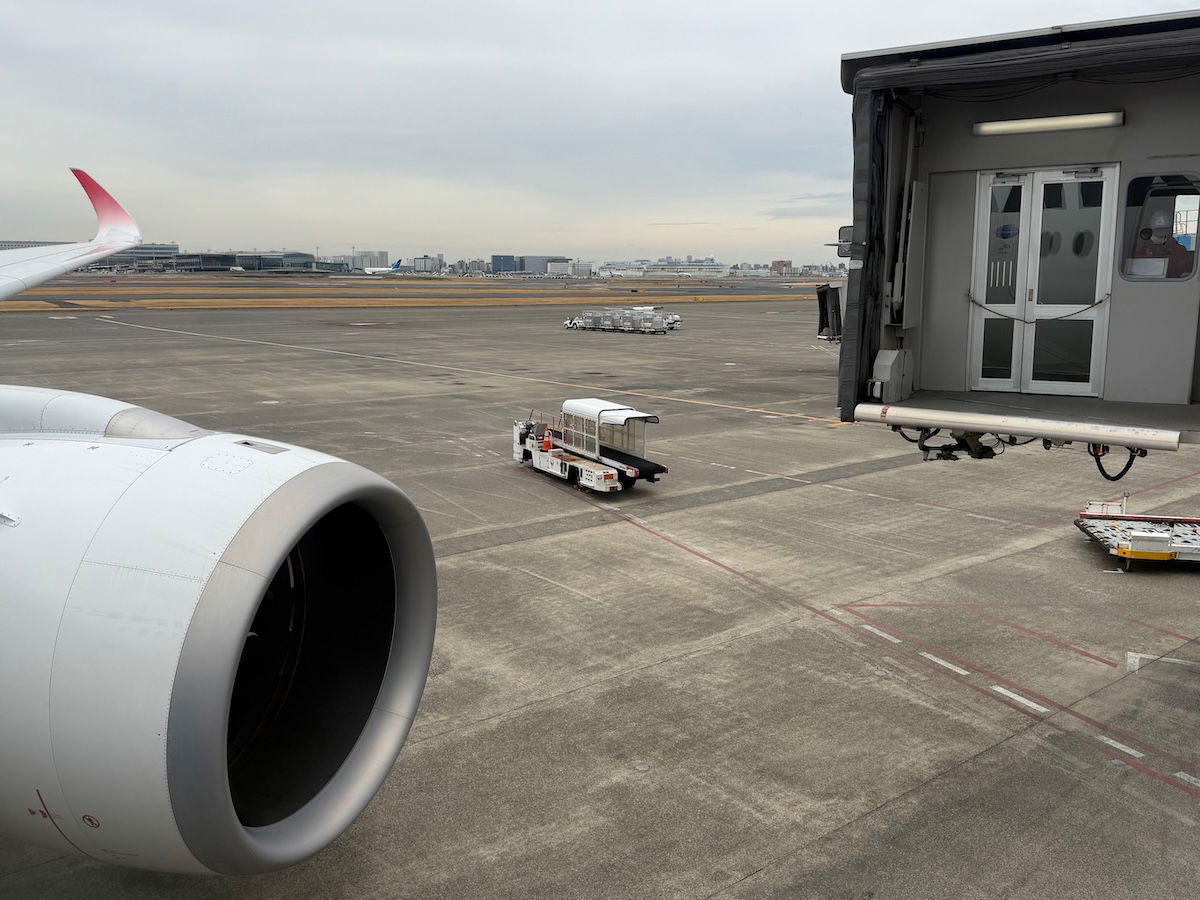
At 11:50AM we started our pushback, and at 11:55AM we started our taxi, as the ramp agents waved goodbye.
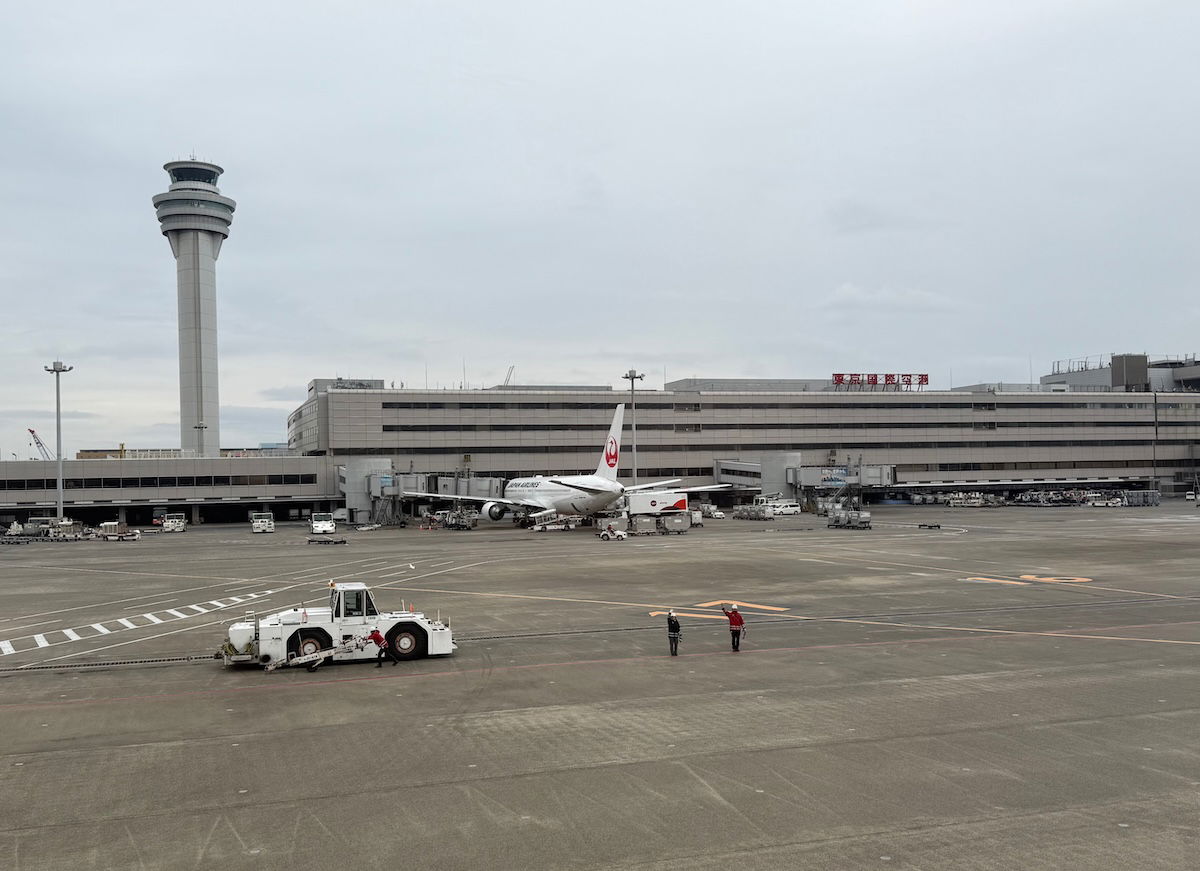
We had a long but fast taxi out to runway 34R, where we were cleared for takeoff at 12:05PM.
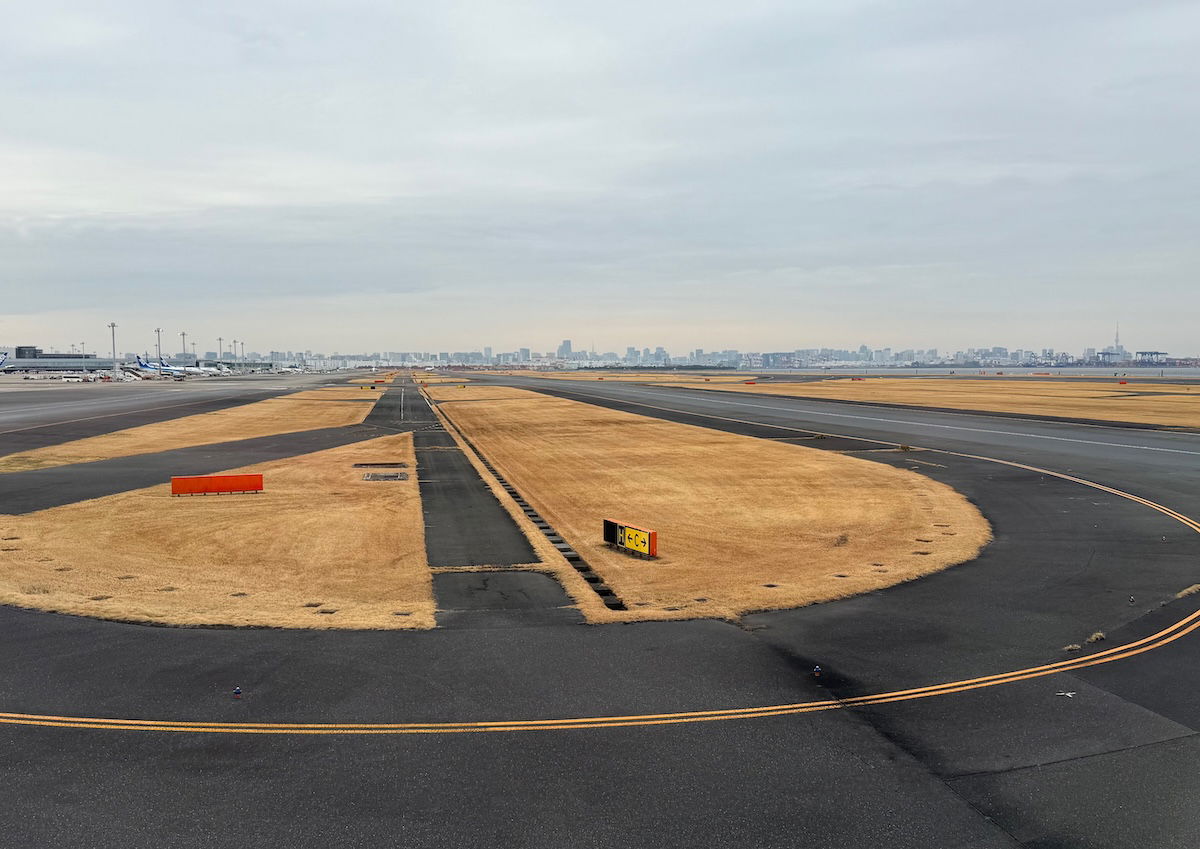
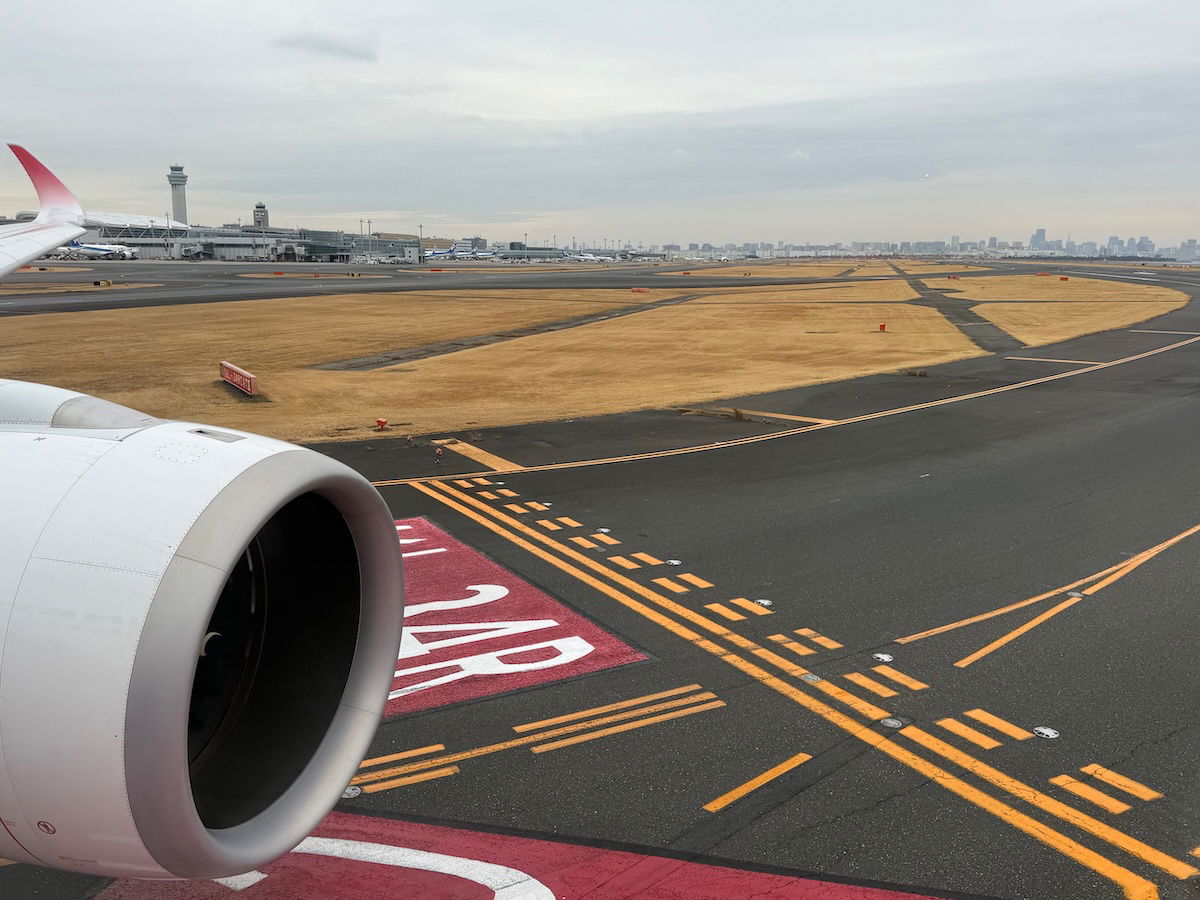
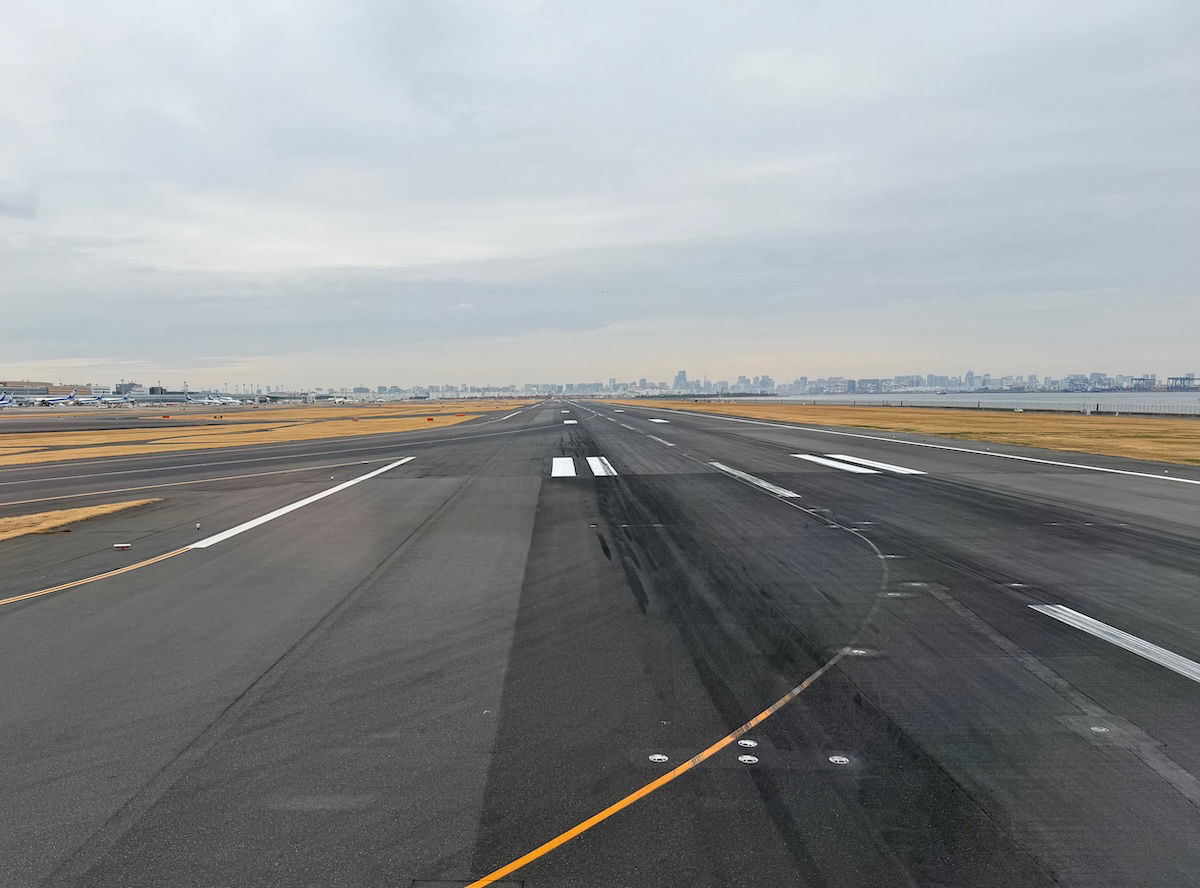
Our takeoff roll was powerful, and we had a smooth climb out of Tokyo, with some awesome city views on departure. Departing from Haneda really is a treat, in terms of the views.
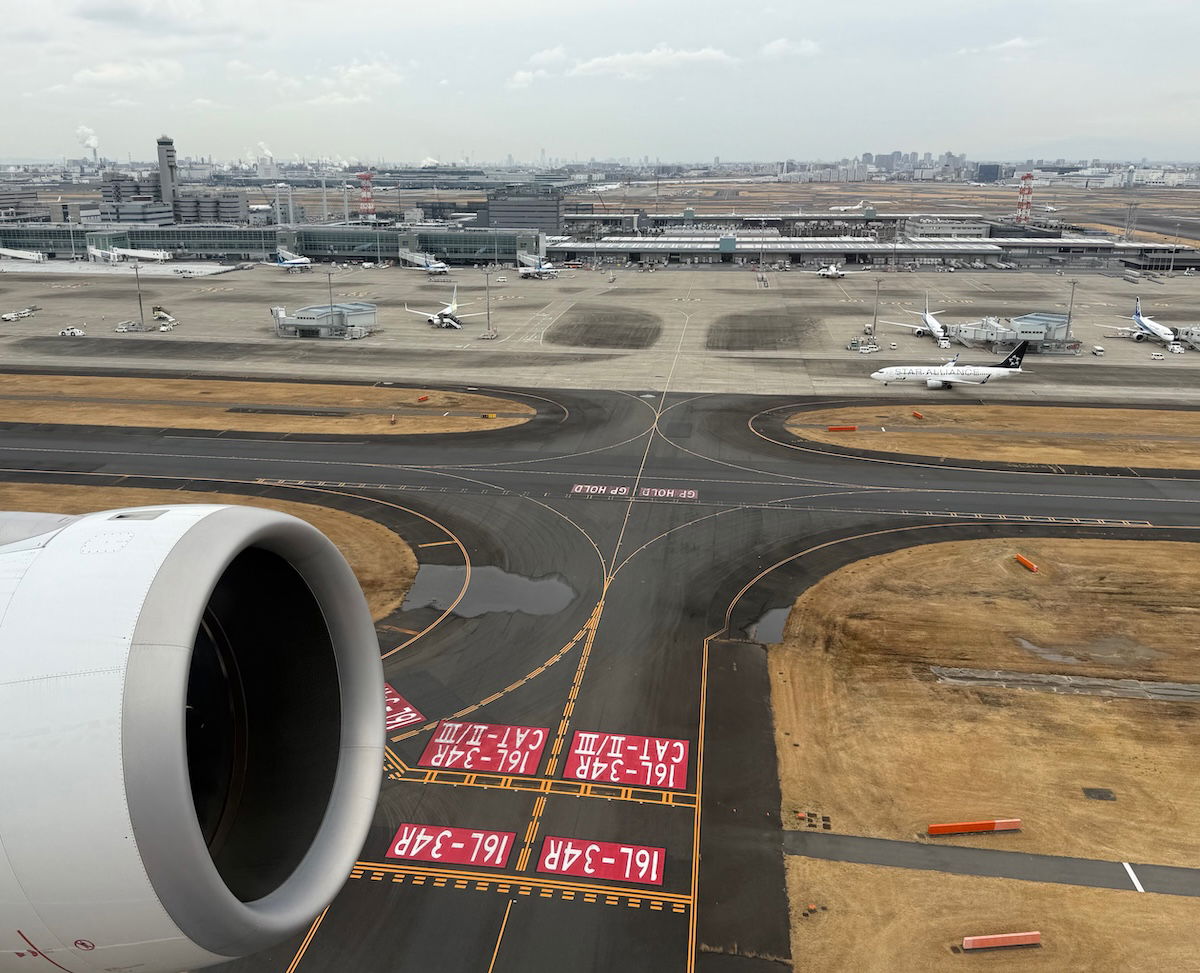
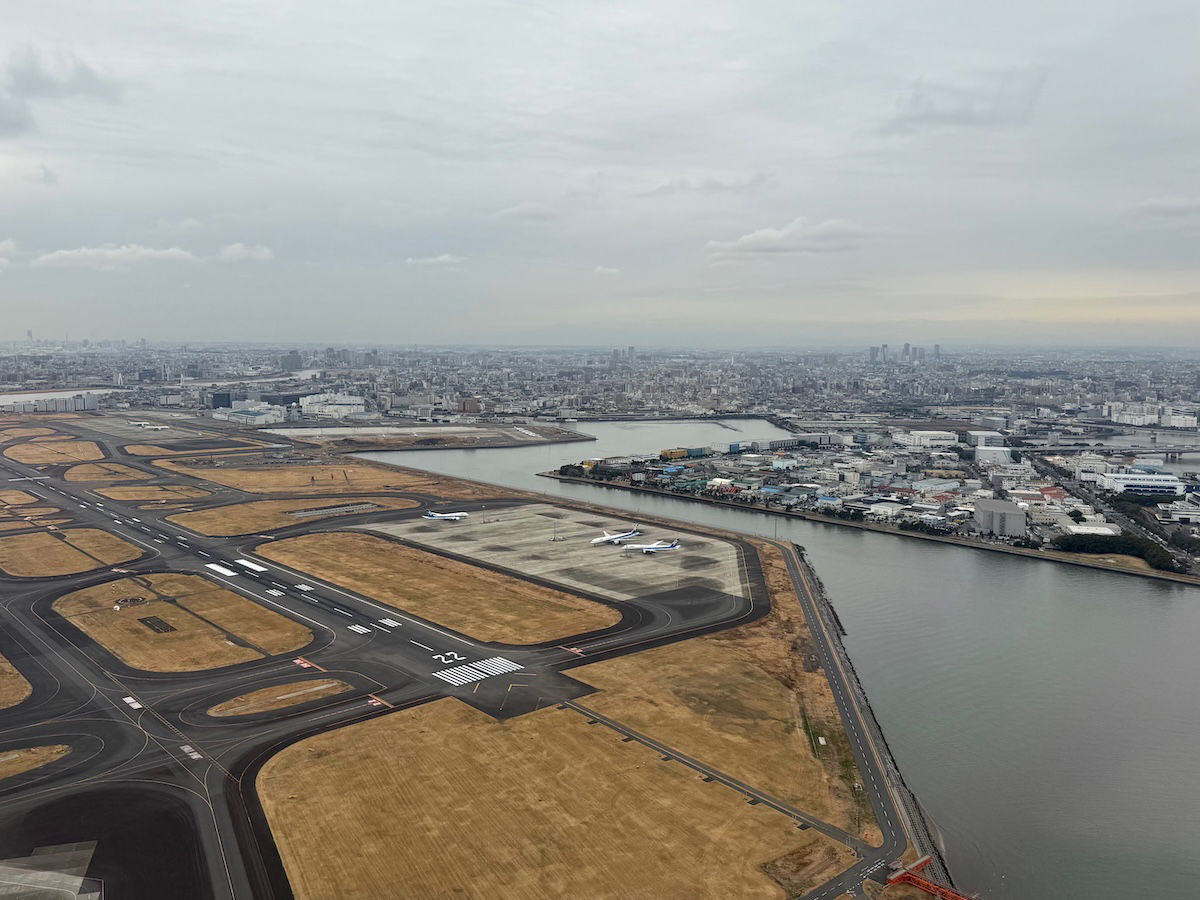
I couldn’t decide whether to focus on the tail camera…
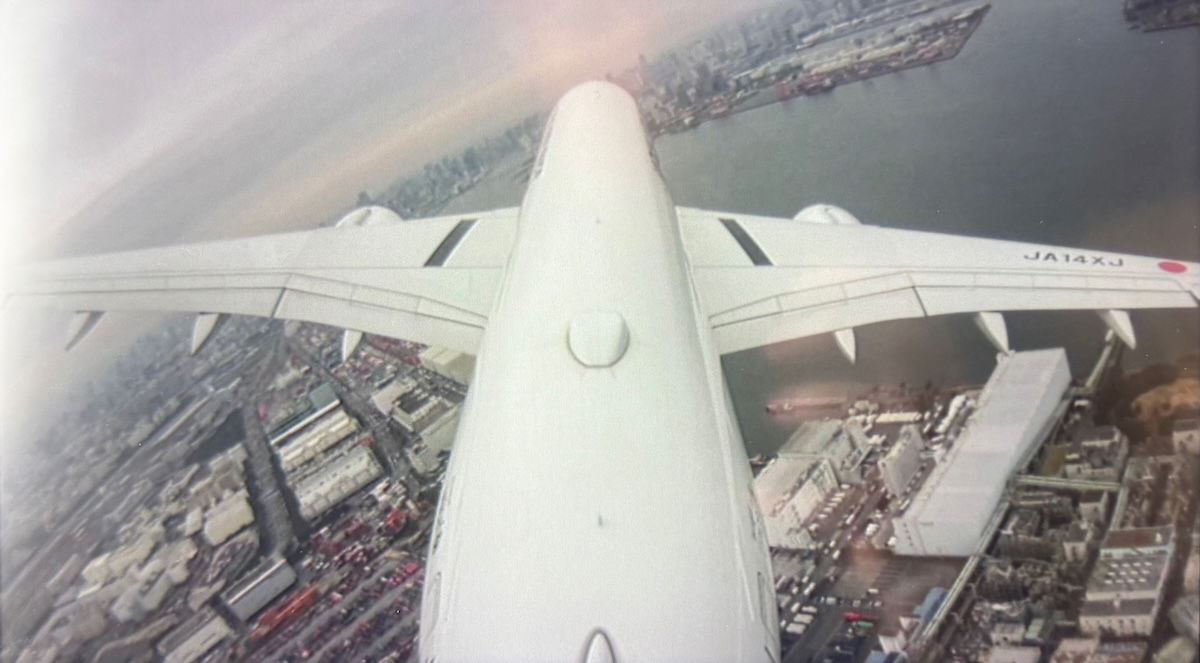
…or just look out the window and take in the engine and city views.
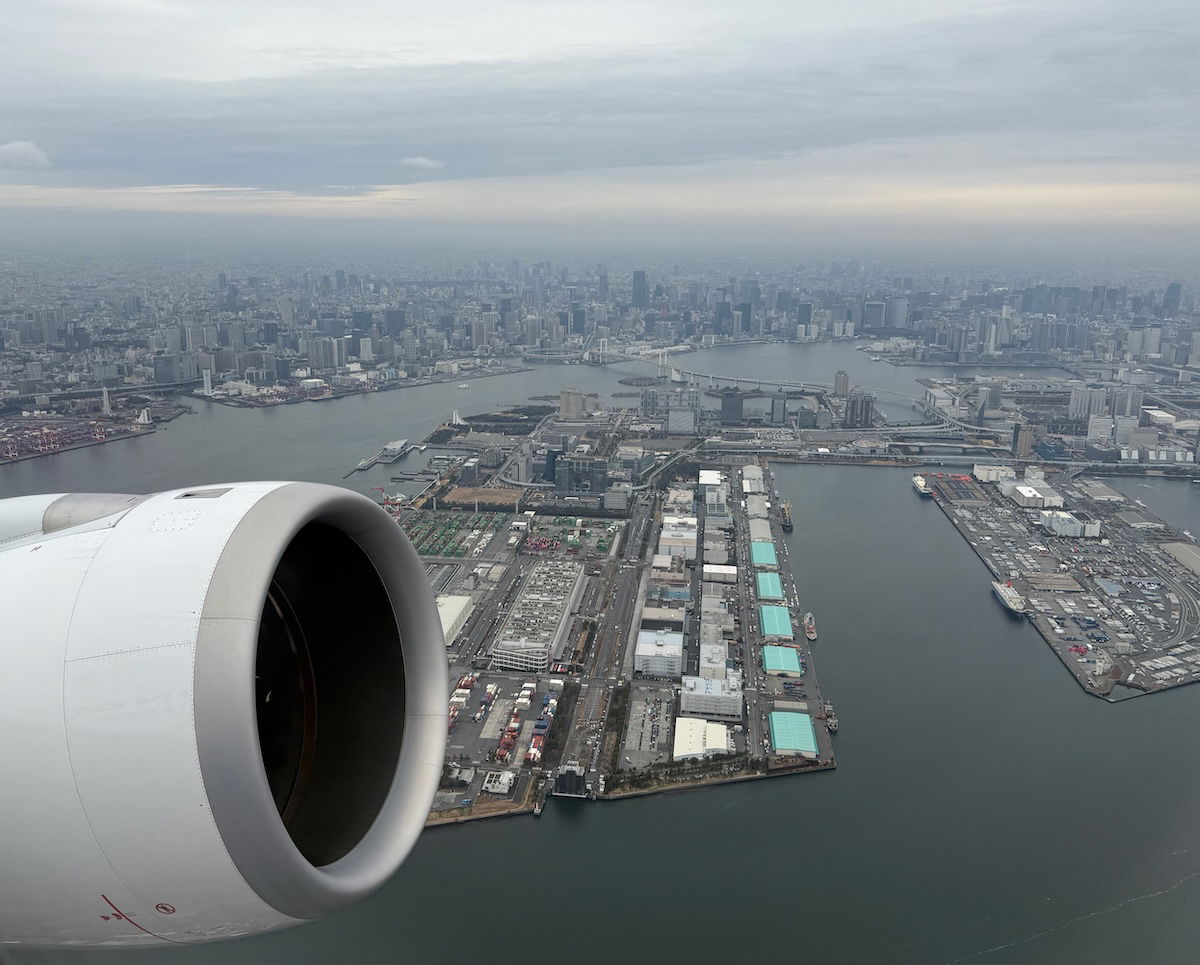
The seatbelt sign stayed on longer than usual, and was turned off around 10 minutes after takeoff.
Japan Airlines Class J inflight service
Once airborne, the crew passed through the cabin with the typical inflight service. Service is identical in Class J and economy, and is also identical across the domestic network. We were served within about 10 minutes of the seatbelt sign being turned off.
With the inflight service, the crew holds a drink menu in front of you, and then you can state which option you’d like. The choices included Japan Airlines’ signature Sky Time juice (currently a peach and grape mix), beef consommé soup, coffee, apple juice, hot green tea, cold green tea, or water.
I selected the signature Sky Time juice, while Ford had the beef consommé, both served in paper cups.
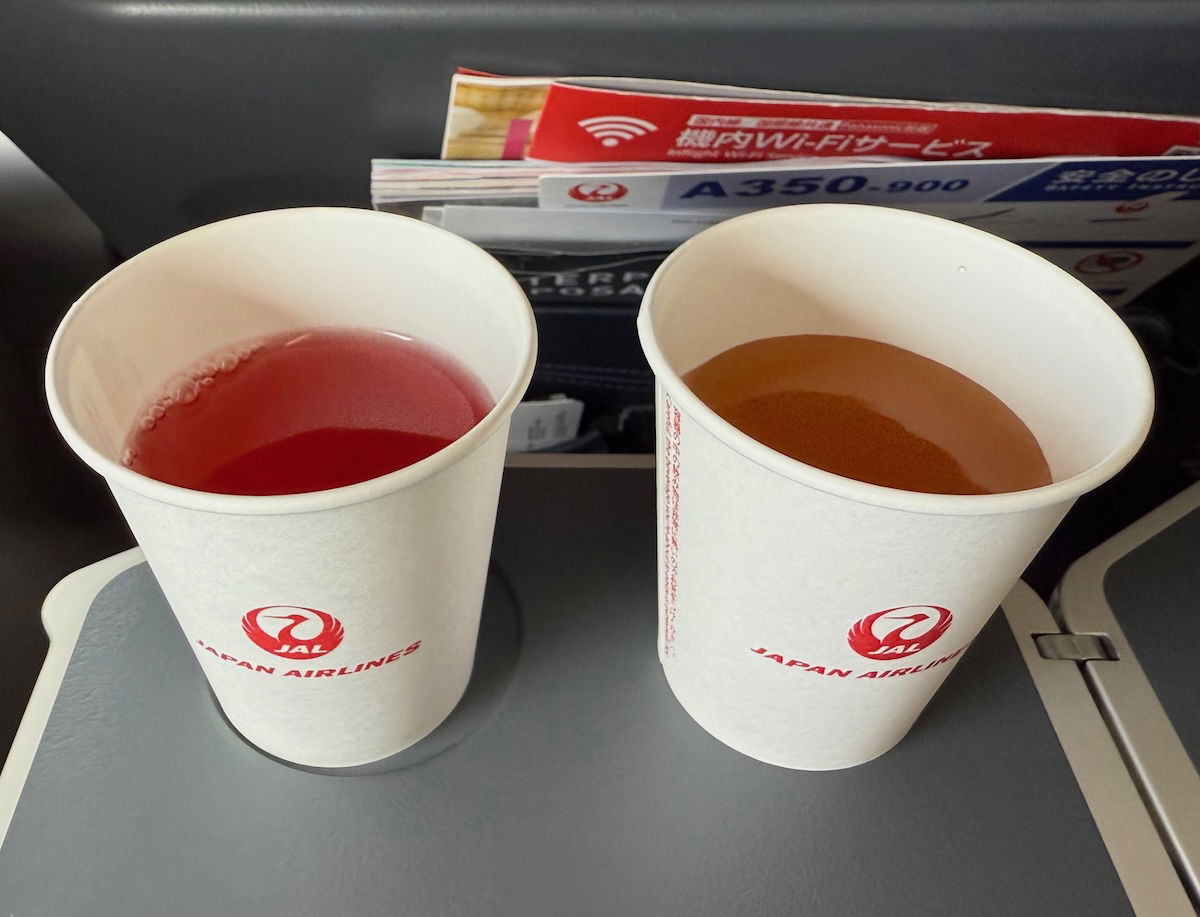
Japan Airlines A350-900 Class J lavatory
During the flight, I checked out the lavatory immediately behind our seat. There are two sets of lavatories by the second set of doors. Since there’s no curtain between Class J and economy, anyone is welcome to use the lavatories.
While there was no bidet feature, how nice (and big) is this lavatory?!?
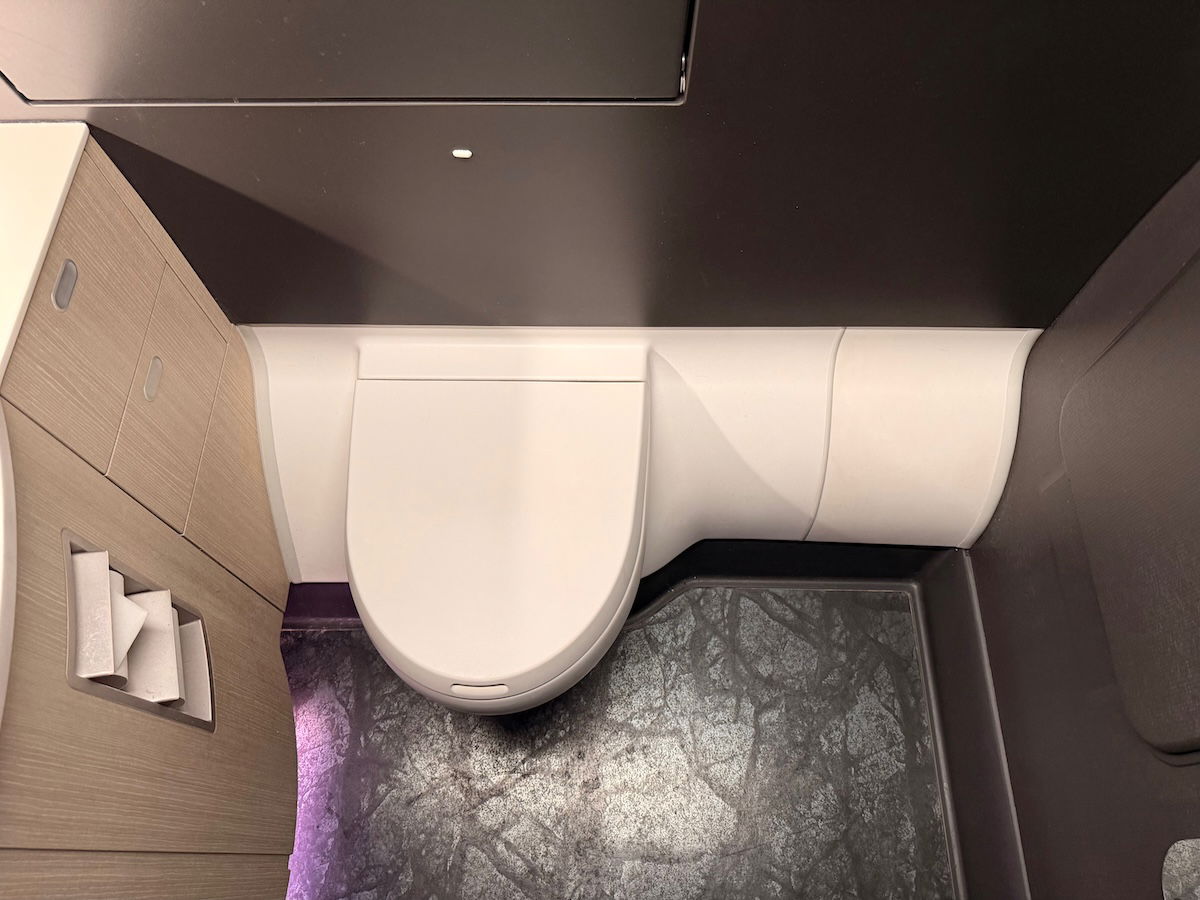
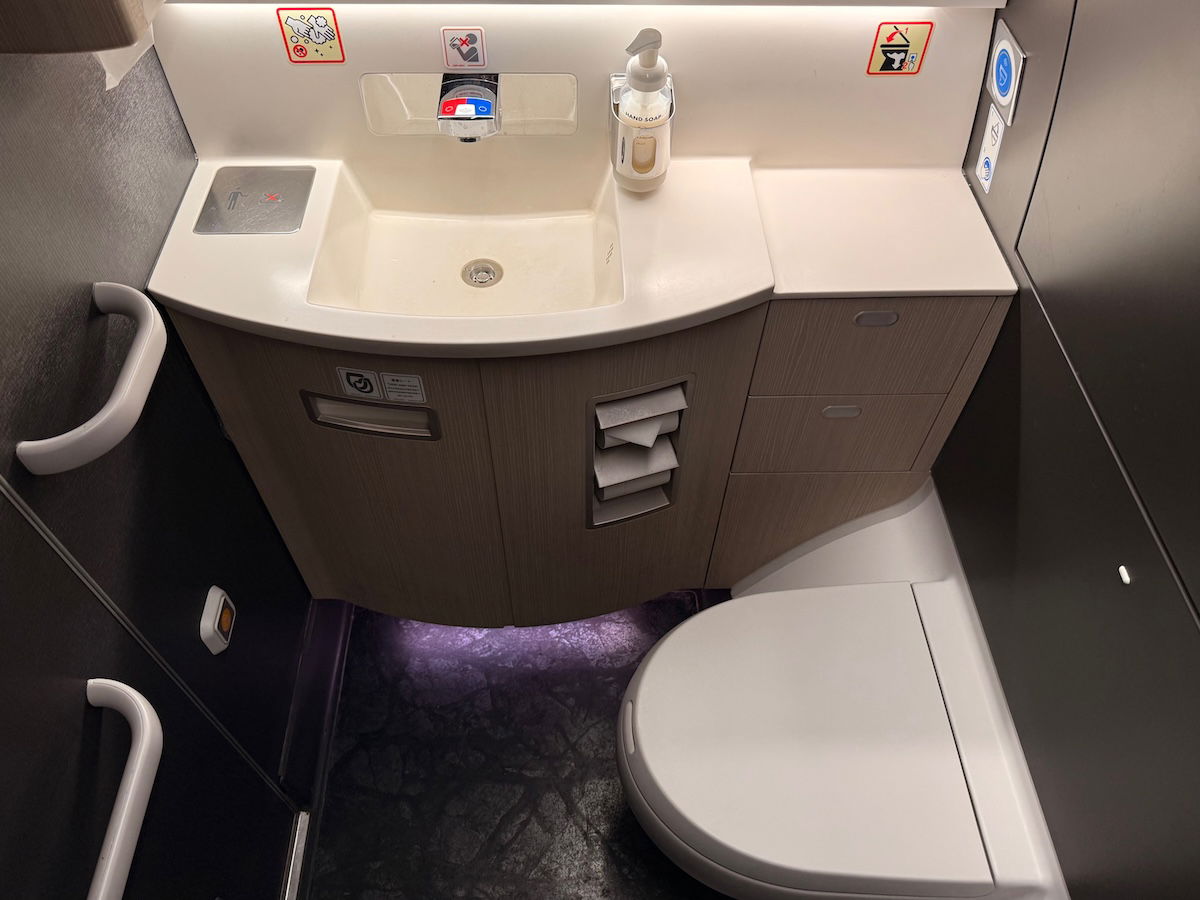
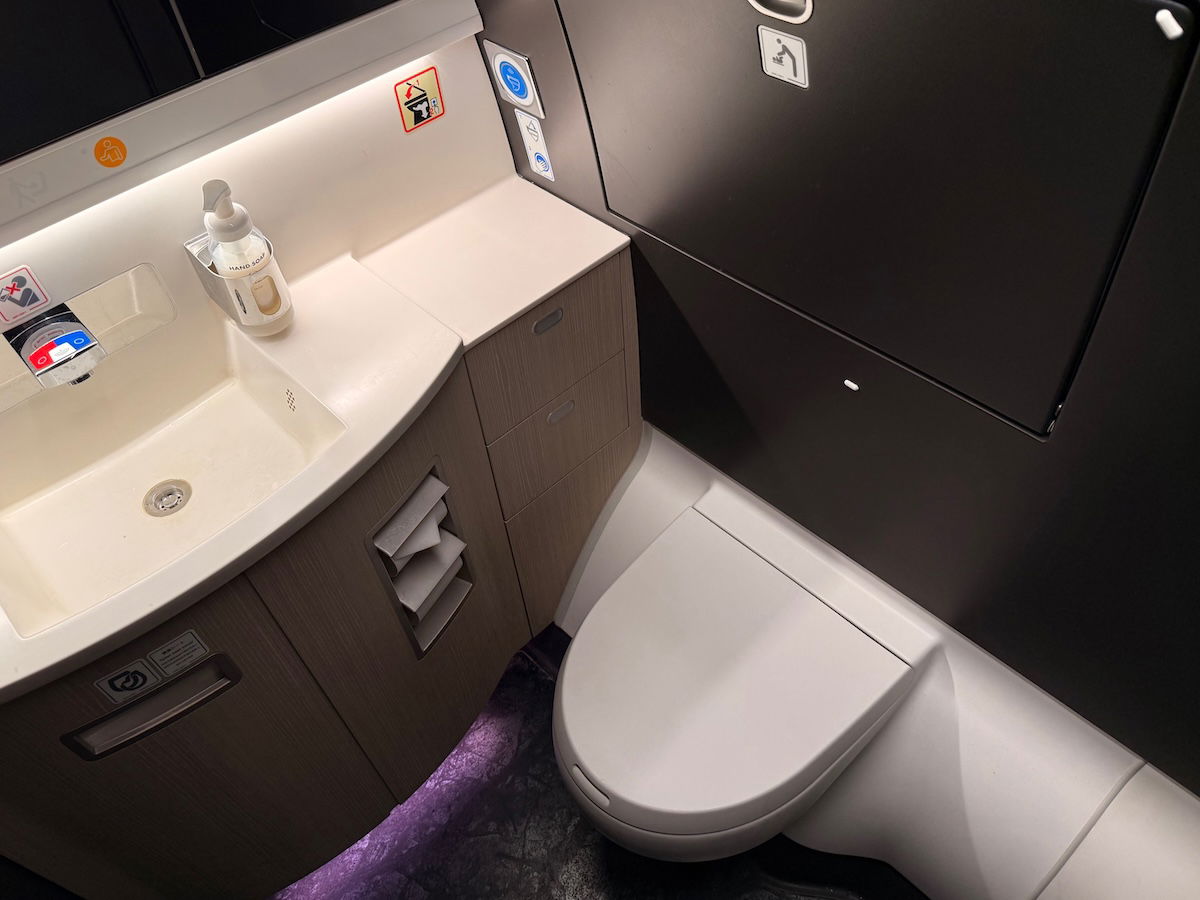
Japan Airlines Class J service
Japan Airlines consistently offers warm hospitality, and this flight was no exception, despite the short duration. As you’d expect, the crew was polite, efficient, and friendly. Of course the service is a bit assembly line-esque, but that’s exactly what you’d expect, given that they have such a short period in which to serve nearly 400 people.
Perhaps what impressed me most is how the crew went above and beyond to embrace me being an aviation geek. Obviously when I review flights, I take a lot of pictures onboard. On most airlines, the crews either look at me suspiciously, or at best, are indifferent. Well, not on Japan Airlines.
For example, at the end of boarding, one of the flight attendants came up to my seat and brought me two postcards about the Japan Airlines A350-1000, saying “I hope you enjoy your flight with us.” To be clear, they had no clue who I am (I mean, I am nobody, but you know what I mean), but rather they just sensed my passion and interest.
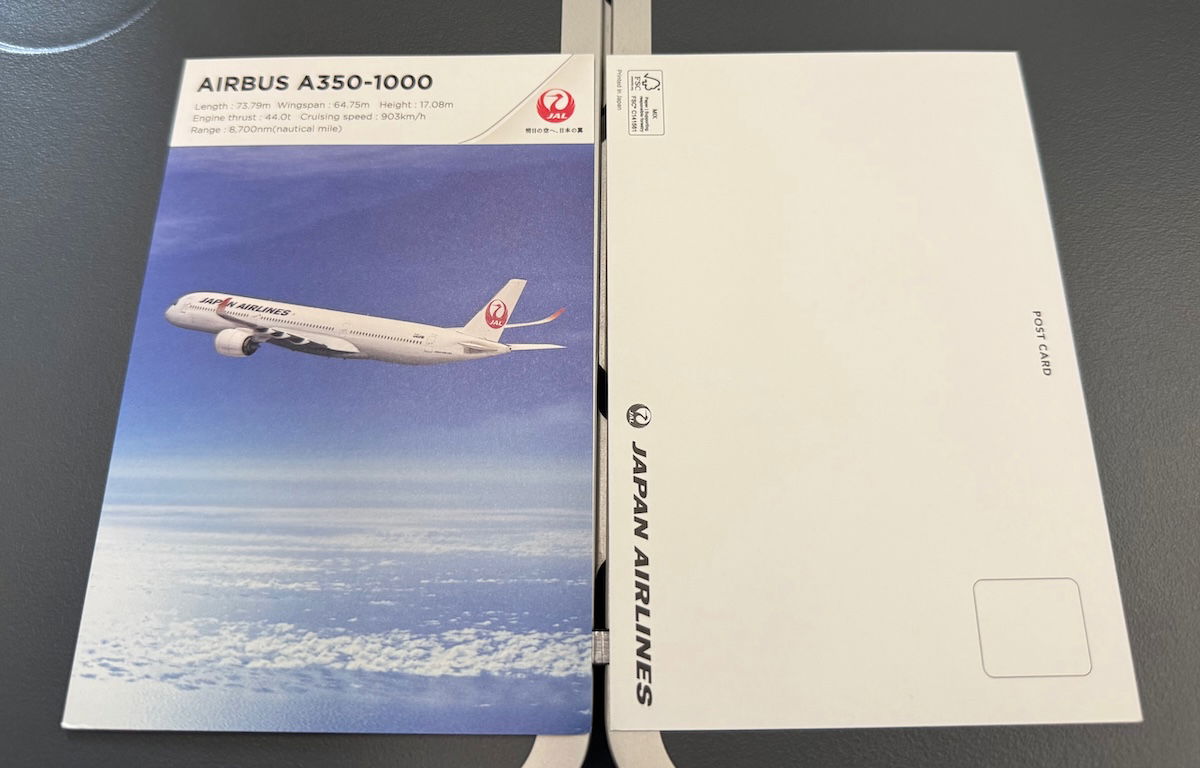
Then at the end of the flight, she brought even more gifts, in the form of Japan Airlines keychains, saying “it looks like you enjoy your flight with us, so here is a small gift.” 10/10!
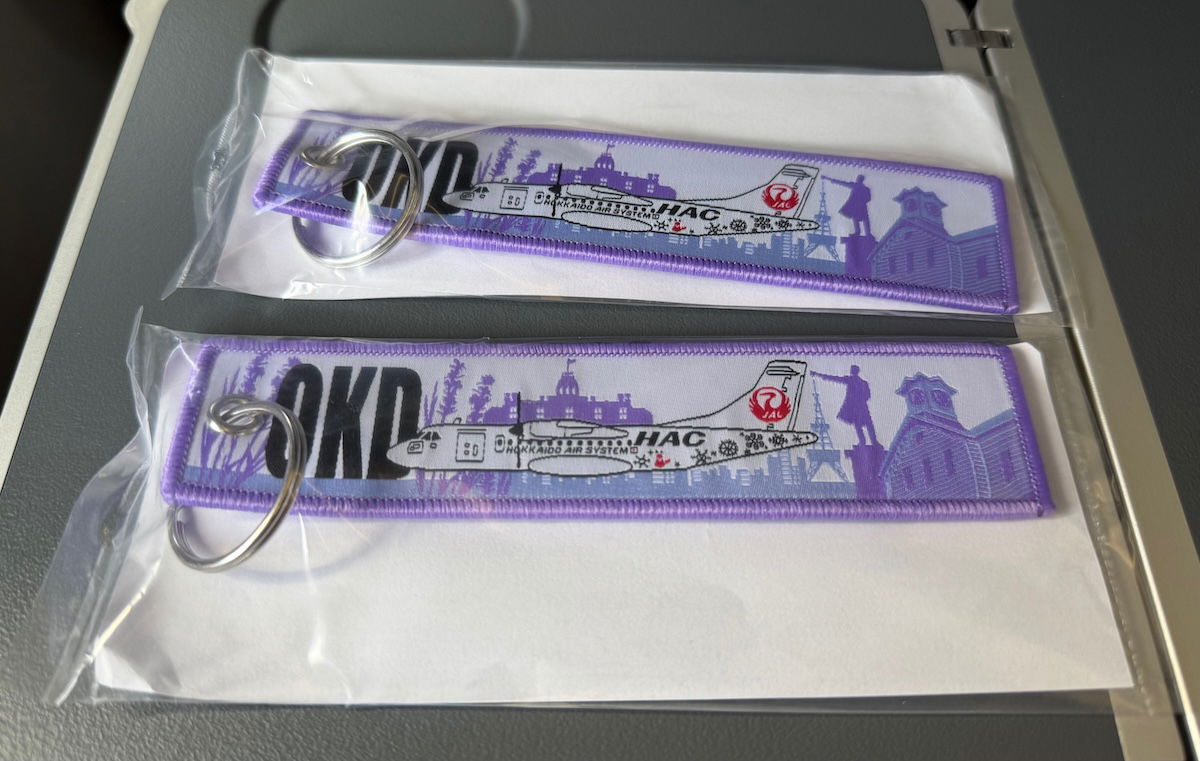
Japan Airlines A350-900 arrival in Sapporo
I spent most of the remainder of the flight just gazing out the window, given the stunning views.


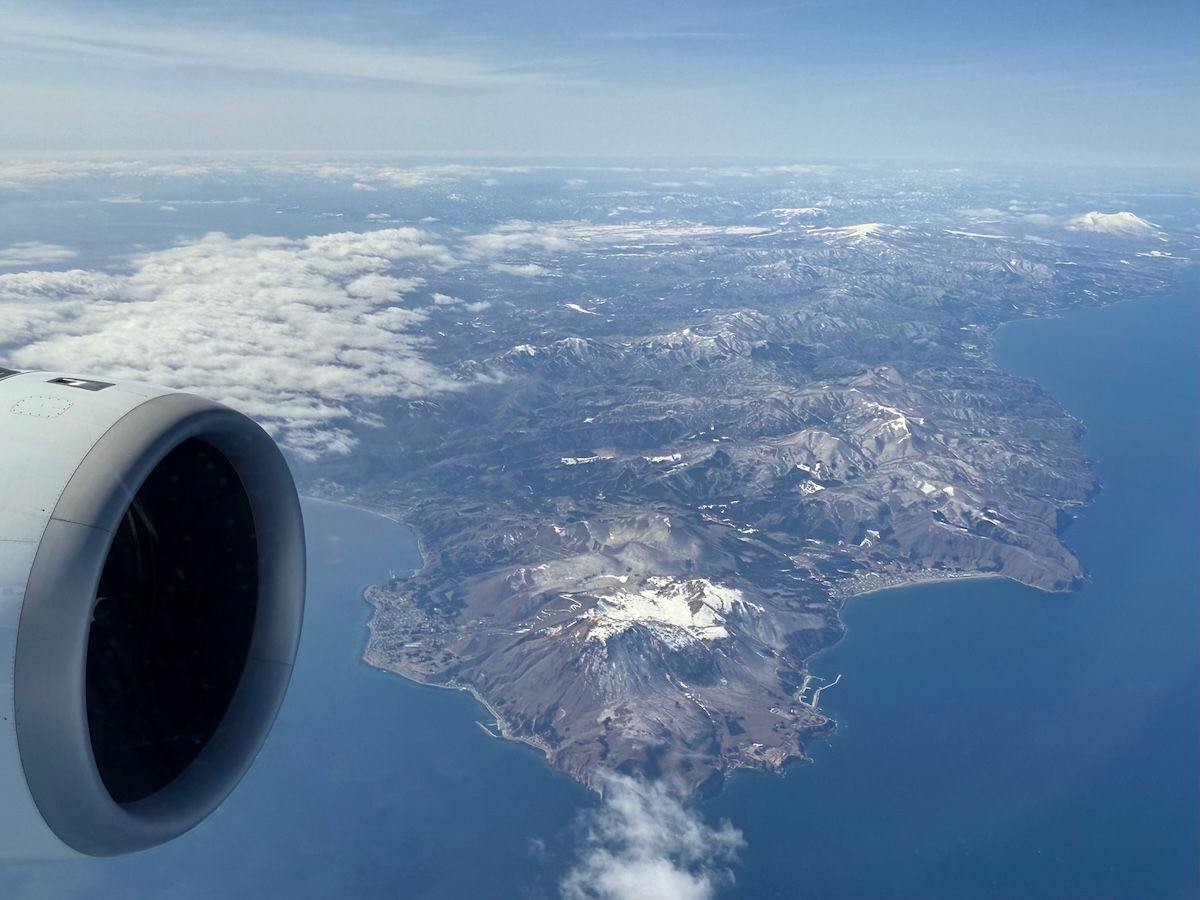
At 12:45PM, 40 minutes after takeoff, we started our gradual descent toward Sapporo. 15 minutes later, the seatbelt sign was turned on, and the crew was told to prepare the cabin for landing.
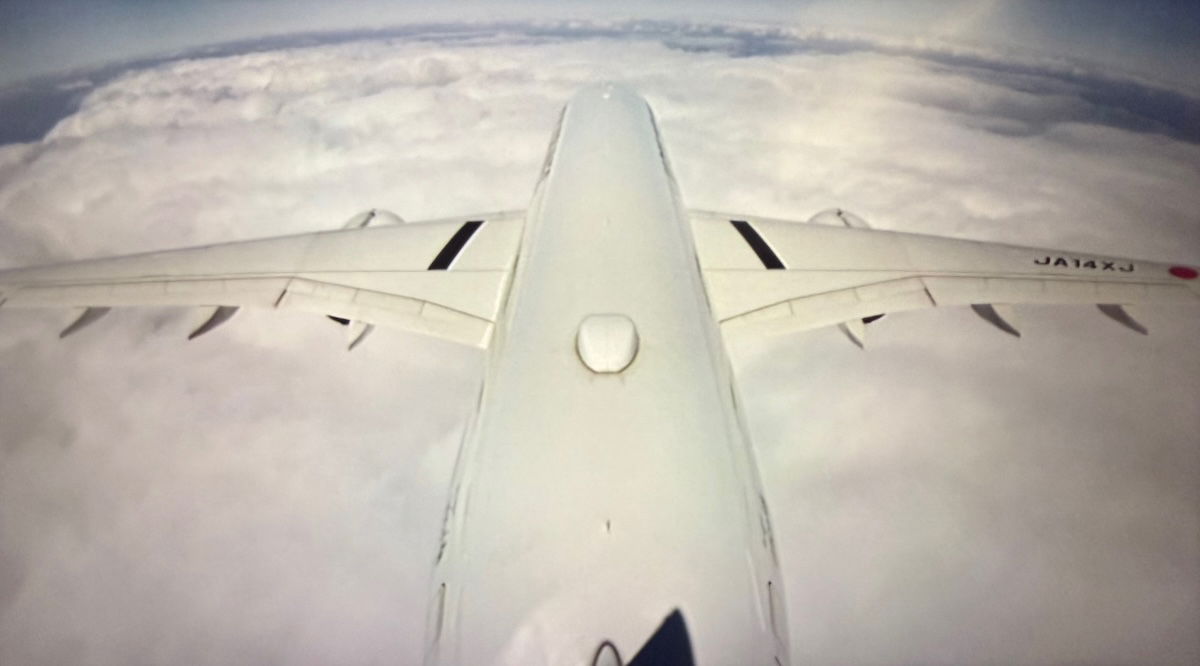
I remembered the approach view from a Korean Air 321neo flight I took to Sapporo several months back, though of course everything looked a bit colder this time around.
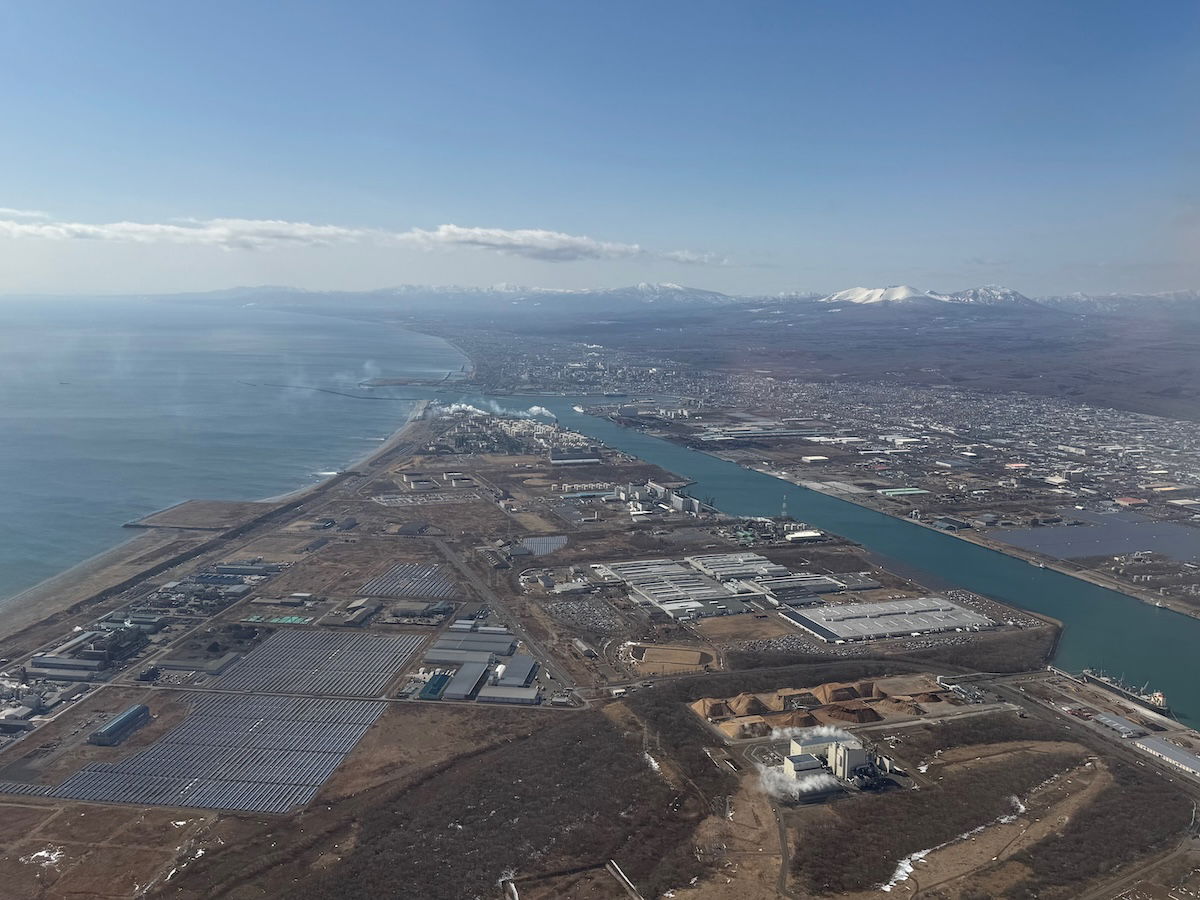

We ended up touching down on runway 1R at 1:15PM.
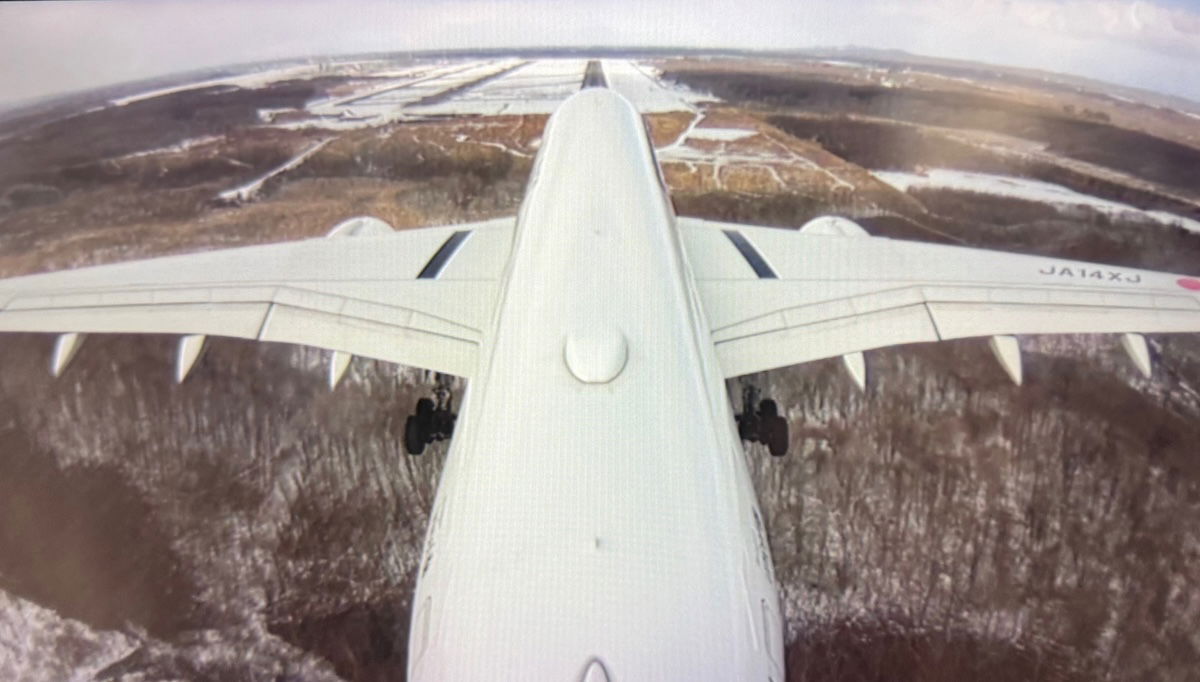

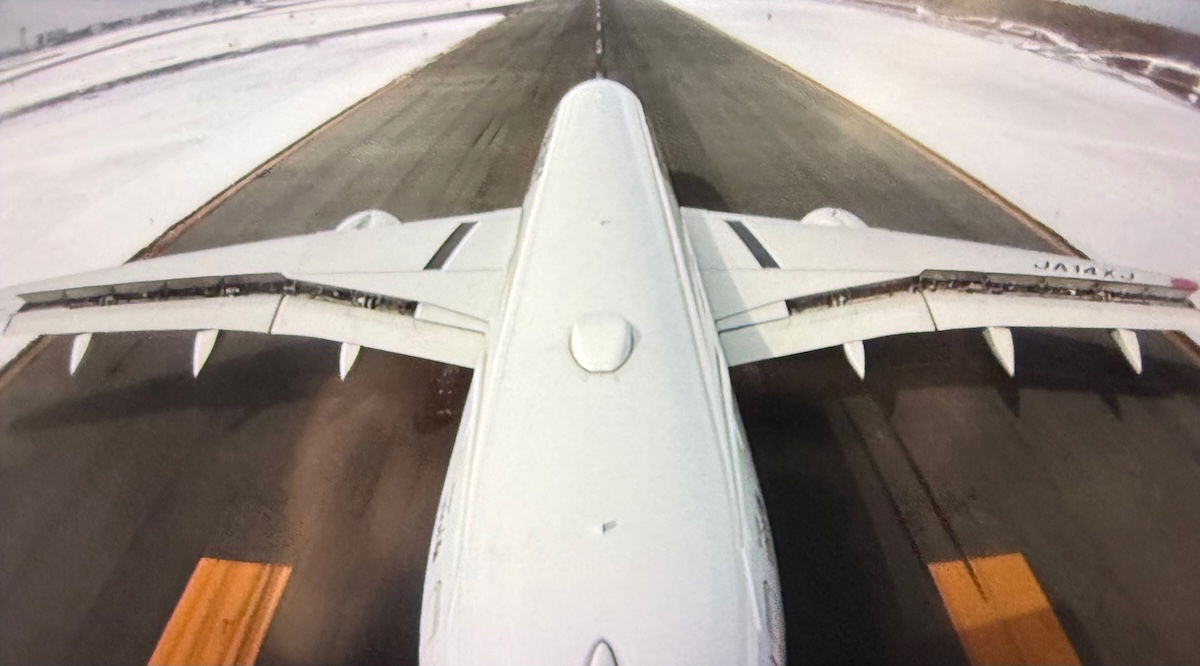
From there we had a five minute taxi to our arrival gate, where we pulled in at 1:20PM, around 10 minutes behind schedule (as you’d expect, the delay caused several more apologies from the crew).

How cute are those pink Fuji Dream Airlines Embraers?!
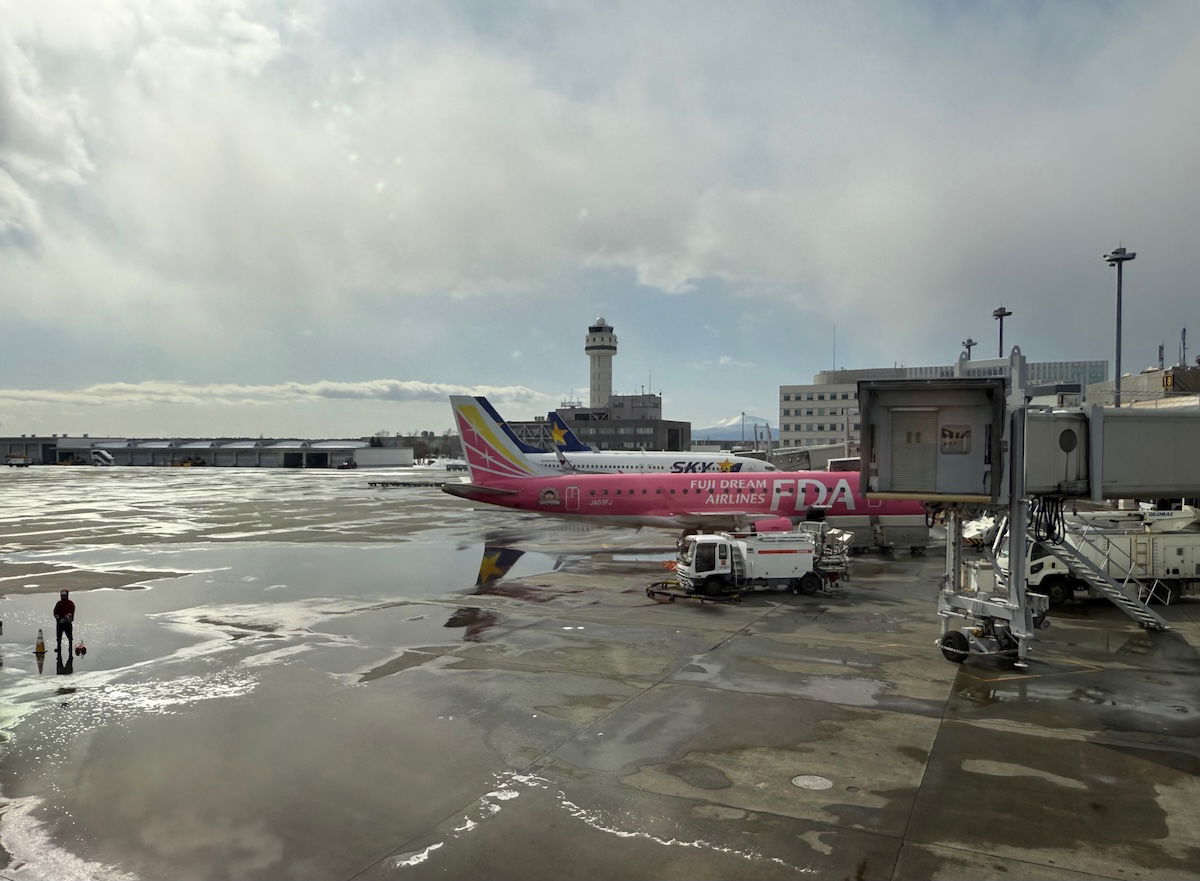
Once off the aircraft, we collected our checked bags, and then around an hour later got onto a bus to drive to the Park Hyatt Niseko, where we’d be spending the next five nights.
Bottom line
Japan Airlines’ Class J on the A350-900 is a lovely, elevated, no frills experience. For a very modest premium, you can enjoy a much more comfortable seat than you’d find in economy, and I think it’s money well spent. The carrier’s A350-900s are an absolute pleasure to fly, thanks to the quiet and comfortable cabin, tail camera, seat back entertainment, free Wi-Fi, friendly service, and reliability.
I wouldn’t hesitate to fly Class J again. However, if you can upgrade to first class, it’s one of the best value premium experiences in the world, if you ask me.
What’s your take on Japan Airlines’ A350-900 Class J?

















I've been looking for and not finding award availability for CTS-HND-JFK, as I want to fly JAL A350-1000 in business class. Any tips on this? I have Capital One miles to transfer.
Keep dreaming!
i think the best value premium experience is an interesting question - I've just booked Aer Lingus from Malaga to Dublin for €205 in their lie-flat A330 seat (except I paid €110 + 8500 avios), and that would be even cheaper in the off season - I contend there isn't really a cheaper lie flat seat anywhere, in absolute terms or per hour (€70/h)
Booked J with VN, the flagship national carrier of Vietnam, from HAN to SGN this October on their A359, lie-flat reverse herringbone for €134 which works out to be €62/hour. This includes priority security line, lounge access and an in-flight meal service. They also offer this route (same price) on their 789 as well.
Air China's CAN-SHA/PVG on A350-900 yields better value on cash
@Ben
Your "not unusual to find class J under 100 USD" is quite misleading looking in on random days in June the lowest is roughly 26,000 yen, going in to mid week days in Early August the 3 last flights from Tokyo (out of 17 for the day) comes in at roughly 15,000 yen. Or 104 USD. That is actually just about the floor, if you don't get a fare sale. Admittedly that would have...
@Ben
Your "not unusual to find class J under 100 USD" is quite misleading looking in on random days in June the lowest is roughly 26,000 yen, going in to mid week days in Early August the 3 last flights from Tokyo (out of 17 for the day) comes in at roughly 15,000 yen. Or 104 USD. That is actually just about the floor, if you don't get a fare sale. Admittedly that would have been less than 100USD when the flights were taken.
It is not usual to find the lowest fare on any departure that is just remotely attractive in timing, and within a couple of months not usual at all to find these 15,000 yen fares in class J. They exist, to say it is not unusual to get them is quite the overstatement.
I think it would be lovely if you could highlight the names of the cabin crew who embraced your avgeeky nature. Having done so on your domestic and international JAL A350 flights in J and F, it sure is something special to get a truly cabin crew, even in domestic Class J. Looking forward to fly Class J myself on the A350 in a few weeks’ time, from FUK to HND!
I took this flight in the other direction also in J. Great as Lucky says. Not mentioned is how pleasant and efficient the boarding experience is, not even in a rushed way. Japanese culture of quiet, respect, and situational awareness is something to behold.
“Adore”?
Very minor nitpick w/ JAL, but I wish they would market their class J as premium economy instead.
When you buy international business class tickets connecting out of HND, you get the domestic leg in class J, instead of First Class, which I think more accurately corresponds to international business class. I know it's hardly the end of the world considering Japan domestic flights are like an hour long, but still
That would be nice, but it mirrors the way public transport is in Japan though so it's likely acceptable and familiar for the local market. Class J is like JAL's version of Green Car lol. Then there's real first class on JAL domestic just like a few shinkansen routes.
Also, there is probably not enough domestic F seats if everyone in intl J was given access. If we look at how small the domestic...
That would be nice, but it mirrors the way public transport is in Japan though so it's likely acceptable and familiar for the local market. Class J is like JAL's version of Green Car lol. Then there's real first class on JAL domestic just like a few shinkansen routes.
Also, there is probably not enough domestic F seats if everyone in intl J was given access. If we look at how small the domestic F footprint is and how many intl J seats there are, intl J would likely fill 100% of the domestic F cabins, which is then not creating a revenue premium / JAL doesn't have to do that. Intl F does get domestic F.
What could be interesting is if full fare intl J gets domestic F, kind of like how JAL gives full fare intl Y a few perks. I wonder how many of those tickets are out there daily.
@yoloswag420
Just fly F to Japan, on a non award fare and your domestic connection will be in F. For award F arrival it will depend on the highly scarce domestic F availability whether you get F or Class J, or more likely Y.
oh thank god.
for a second I thought you flew Economy.
Love your reviews. Thanks for the amazing content. Would love some help for a point review issue I'm having for late August if you happen to be bored and have time...
Nice review. It's a shame you don't review more Econ or PremEcon long haul products - I'm sure many of us would be interested in that.
The point of the blog is redeeming points for travel experiences that most people don't pay cash for. Economy is economy is economy - you're squeezed in, fed & watered to a tight budget, and have a few movies thrown at you. The only really difference is the uniforms on the cabin crew.
Yeah but there is some value to showing the occasional long haul premium economy review.
@Aaron? For what? The seat was a little better than I expected. The carrots weren't so mushy. It's still an increment above economy. The max value is in the J and F redemptions.
then go make an economy and premium economy blog yourself and see how it goes. Most people aren't interested in that, because everyone knows what economy offers. Most of the population, even "frequent" travelers haven't flown international first or business class. So people want to read about it!
I totally agree.
Regarding the paper cups they use, I get that they're going for sustainability, but I wish they'd go for a reusable option like ceramic or glass; don't you think single use cups defeats the purpose of trying to eliminate wastage?
Besides, I like my coffee in proper ceramicware anyway ;)
The paper cups weigh next to nothing and can be recycled. Glass or ceramic would be considerably heavier. The combined, network-wide weight saving over the course of a year would mean a decent saving on the company's fuel bill. If you're doing short hops between Japanese cities, you can live with a paper cup.